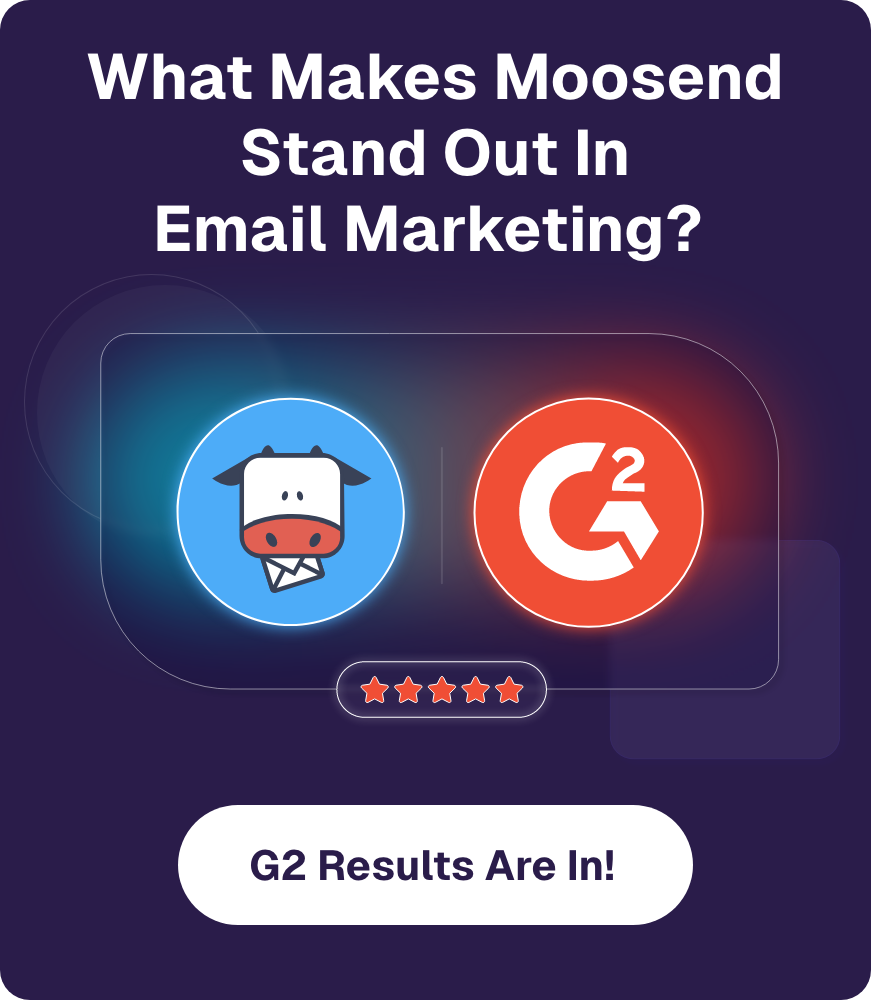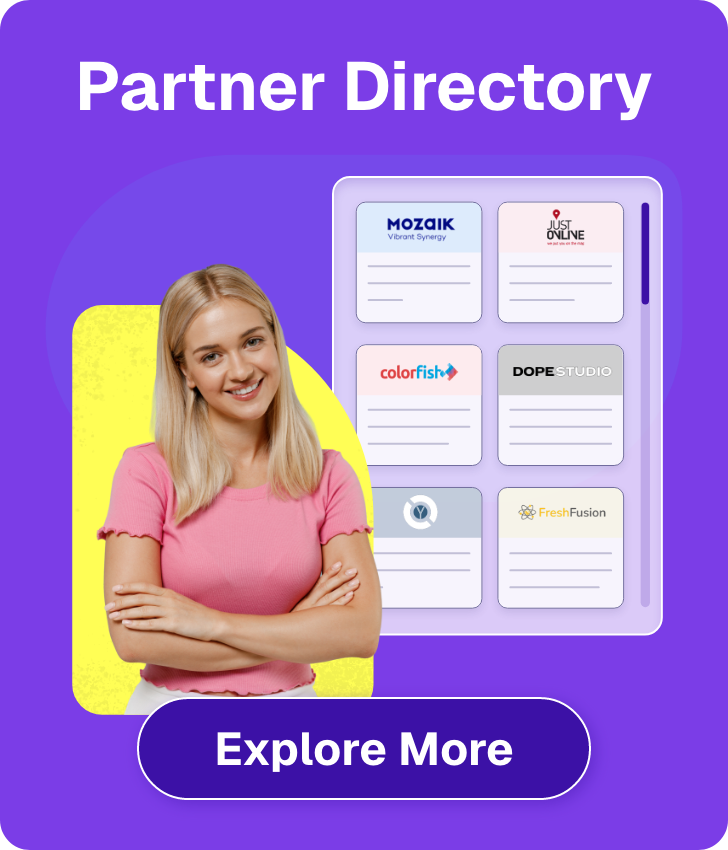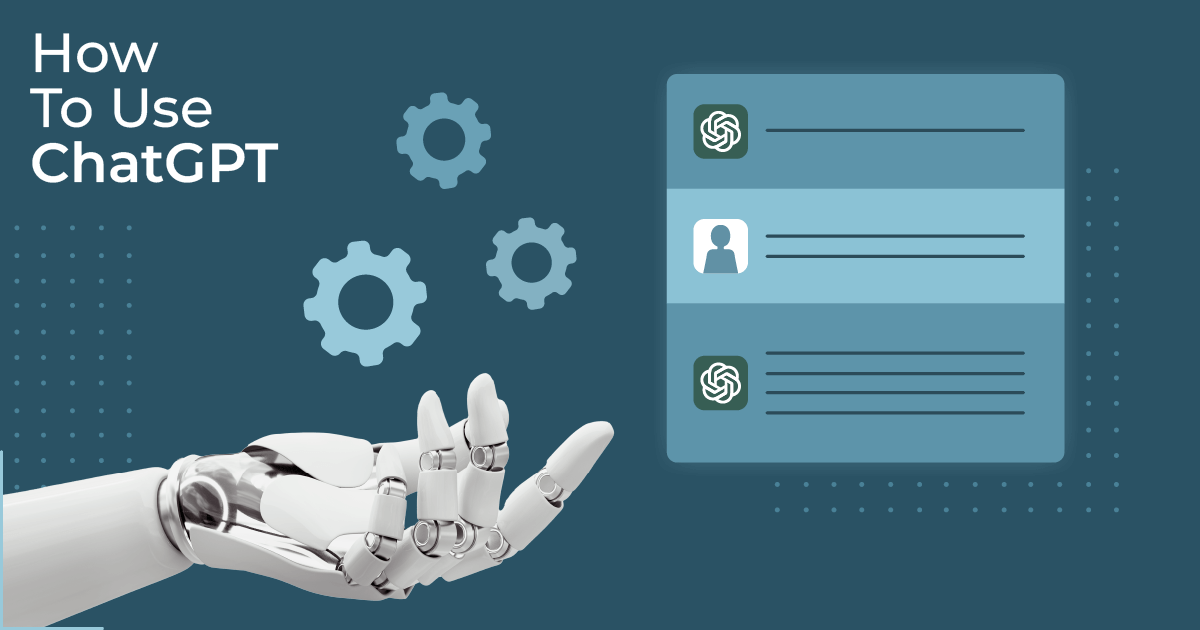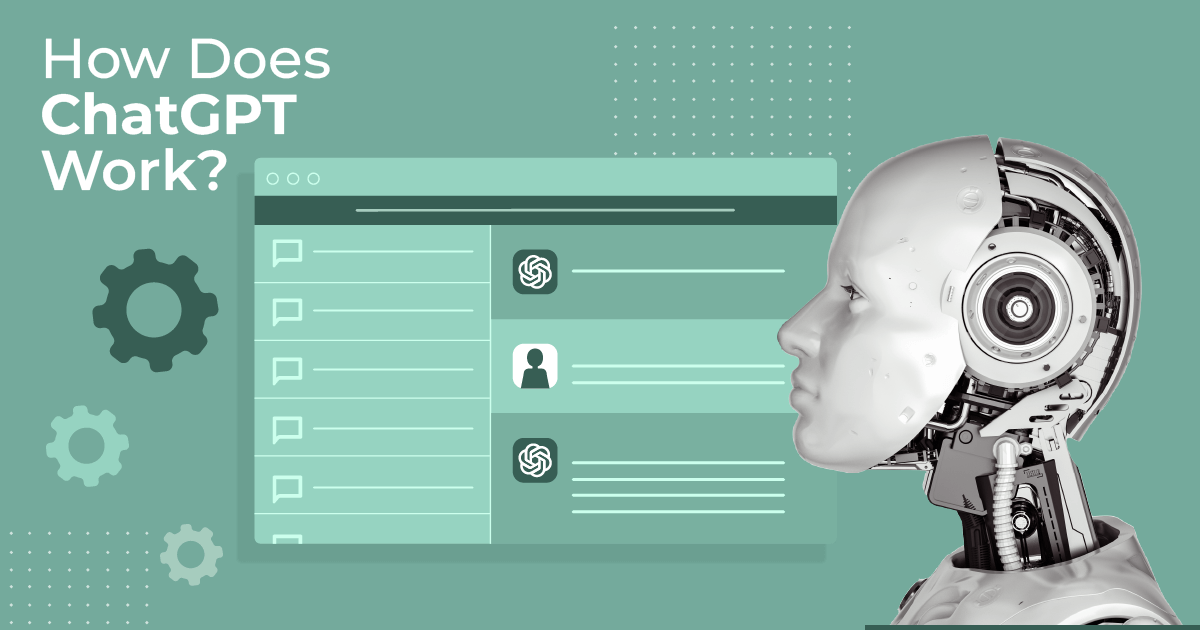
27 Innovative ChatGPT Prompts For Email Marketing [+Output]
During your email marketing journey, you may feel overwhelmed by the planning and brainstorming required before sending your email campaigns.
That’s where artificial intelligence, like OpenAI’s ChatGPT, swoops in to save the day. Using ChatGPT prompts for email marketing can help you save time and resources, especially if you have a busy schedule or are experiencing a creative block.
If you’re new to using generative AI, creating ChatGPT prompts might initially seem daunting, and you might find the outputs not quite what you expected. But don’t worry, we’ve got your back.
In this guide, we’ll see some popular email marketing use cases, a simple method to get more relevant outputs, and ideas to get you inspired.
How Can ChatGPT Prompts Be Used for Email Marketing?
ChatGPT has many applications in AI email marketing, and some may even surprise you. Below are the most common use cases.
1. Email content & calendar
You can use ChatGPT to generate content for various parts of your email campaign:
- Email subject lines
- Preview text
- Email body copy
- Calls-to-action (CTA)
You can use AI to generate various email types and even save them as templates, like welcome emails, product announcements, webinar invites, follow-ups, and more.
Additionally, you can prompt ChatGPT to create a detailed email marketing calendar with specific dates for upcoming campaigns. This way, the software can help you align your campaigns more effectively as you won’t have to do it manually.
2. Segmentation & personalization
You can use ChatGPT to get ideas for lead magnets, like white papers and ebooks, that help you grow your email lists.
Then, it can help you define and understand your target audience based on demographics, psychographics, interests, pain points, and even behavior patterns.
Once you’ve established these factors about your target audience, you can ask ChatGPT for strategies to help you segment them. This means you can send targeted, personalized content to the people it will resonate with the most.
Finally, you can incorporate ChatGPT’s insights into your email marketing strategy and utilize the data to refine your email segments.
3. A/B testing
ChatGPT can also assist you with A/B testing. It can create variations of content, such as body copy, subject lines, and calls-to-action (CTAs), tailored to specific audience segments or your testing criteria.
Moreover, it can interpret the data, help you identify the winning combinations, and explain why they were most effective.
While this is a great way to do an A/B test, don’t forget that it’ll be based on assumptions. For actual split testing, you should invest in an email marketing platform with dedicated A/B testing features. This way, you can run tests and identify the winning variations based on actual subscriber and customer data and preferences, rather than relying solely on suggestions.
4. Automated and transactional emails
Once you have set up automated email response triggers, you can use ChatGPT to craft clear, concise email copy that is user-friendly and appealing to the recipient.
You can also use ChatGPT to create copy for your transactional emails, like order confirmations, shipping notifications, account activation emails, password resets, and payment receipts.
5. Compliance assistance
This is an often-overlooked strategy, but you can use ChatGPT to ensure your content creation complies with various regulations, such as GDPR, CAN-SPAM, and CASL. For the best results, you’ll need the premium version.
If you need a reminder about the ins and outs of these regulations, you can prompt ChatGPT to provide you with the details in a clear and concise format.
How to Create Good ChatGPT Prompts for Marketing
Creating a prompt isn’t rocket science. But, as you may have noticed, sometimes inserting one doesn’t give you the answer you’re looking for. Hence, you spend time tweaking the same prompt repeatedly to get the desired response. This defies the whole purpose of using ChatGPT prompts for marketing.
To avoid that, you can use the C.R.E.A.T.E framework to generate input that ChatGPT will interpret the right way:
- Character: Give ChatGPT some context by assigning it a character. For example, write an introduction like “you’re an email marketer for an eCommerce store selling cosmetic products.”
- Request: Proceed with the actual request using natural language and simple sentence structures. The more detailed you make your request, the better it’ll be.
- Examples: Provide specific examples to guide ChatGPT in the right direction. For instance, ask the chatbot to draw inspiration from someone or something.
- Adjustments: Insert additional elements to make the information more relevant to you, such as what to include or omit from the output.
- Type of output: Specify the format of your result. It can be a table, paragraph, bullet points, and more.
- Extras: Provide ChatGPT with additional context by asking questions before generating an output, ignoring previous results, or requesting an explanation of its reasoning.
Let’s see what ChatGPT generates when we feed it a prompt for Christmas email marketing campaign ideas:
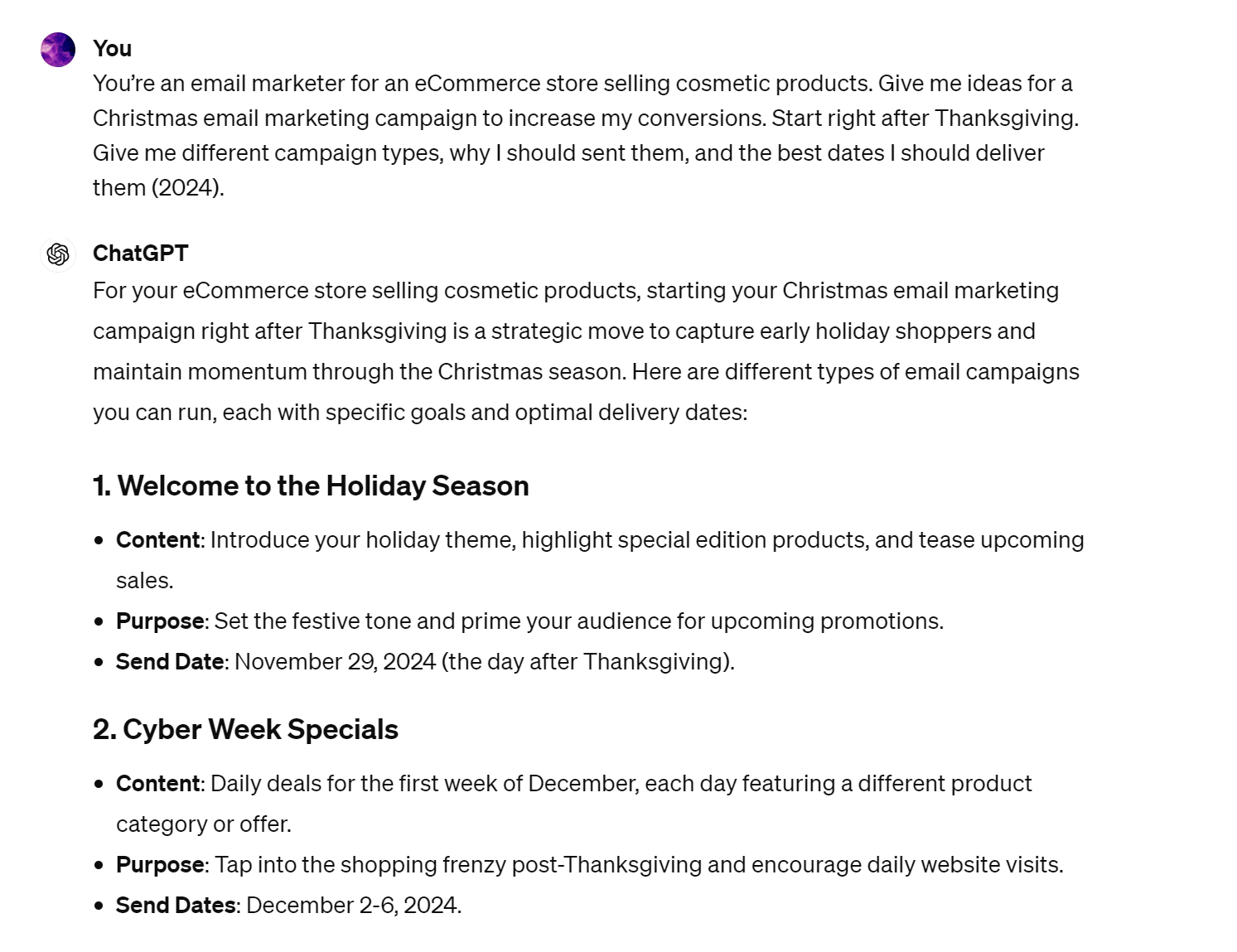
As you can see, the chatbot gave us exactly what we were looking for, explaining the purpose of each campaign.
Should You Use the Free Version or Get a Paid Plan?
The free plan is solid if you just want to try GPT-5 for everyday tasks. You get web search, voice mode, image generation, and even file uploads, but usage limits are quickly apparent if you rely on them often.
The paid tiers expand those limits and add advanced features. Plus ($20/month) gives you smoother access, stronger voice options, and the ChatGPT agent. Pro ($200/month) takes it further with unlimited GPT-5 Pro, extended video generation, and higher compute power for complex work.
In practice, free works well for casual use, but if you’re serious about productivity, Plus feels like the real upgrade.
Is Prompting Limited to ChatGPT?
While we used ChatGPT to generate our output, you can take advantage of ChatGPT’s alternatives to receive relevant results.
Below, you can find some of its top competitors:
- Microsoft Copilot: Best for integrating with Microsoft 365 apps.
- Google Gemini: Best for leveraging Google’s reach capabilities.
- Jasper.ai: Best for marketing content and high-conversion copy.
- Semrush ContentShake AI: Best for SEO-optimized content using deep keyword and competitor analysis.
- Claude: Best for natural text-based conversations and content generation with a human-like tone.
Keep in mind that these tools may produce unexpected or inaccurate results; therefore, it is essential to always verify the output and adjust your prompts to obtain more relevant information.
Moreover, since some of these chatbots require a paid subscription to function at full capacity, you could get an email marketing platform with built-in AI features like Moosend or Mailchimp to save money and time.
Now, let’s get you inspired with some great prompt ideas.
Best Prompts for Unique Email Content Ideas
Unique content is the cornerstone of any great email marketing strategy and campaign. Sometimes, though, it can be hard to come up with content ideas that are original and not overdone, especially if you operate in a saturated market.
Let’s look at prompts that can help you in the ideation phase.
Prompt #1: Seasonal campaign content ideas
With this prompt, we want ChatGPT to produce timely and seasonally relevant content ideas that fit with upcoming holidays, events, or trends.
Remember, before creating your prompts, you can provide the program with more context by specifying the ‘who’ and the format.
Here, we tailored the prompts to a hypothetical eCommerce business that sells women’s skincare products. You can swap the part in brackets for an explanation of your business when you use the prompts.
Prompt: Create a list of email content ideas for seasonal, Christmas-related email campaigns for [an eCommerce business that sells women’s skincare products].

Prompt #2: Interactive content ideas
Interactive content is a powerful tool to add to your email campaigns as it enhances subscriber engagement and interaction. Here’s a prompt that will help you ideate interactive email content like quizzes, polls, surveys, and games.
We used the same hypothetical eCommerce business for this prompt.
Prompt: Create a list of interactive email content ideas for [an eCommerce business that sells women’s skincare products].
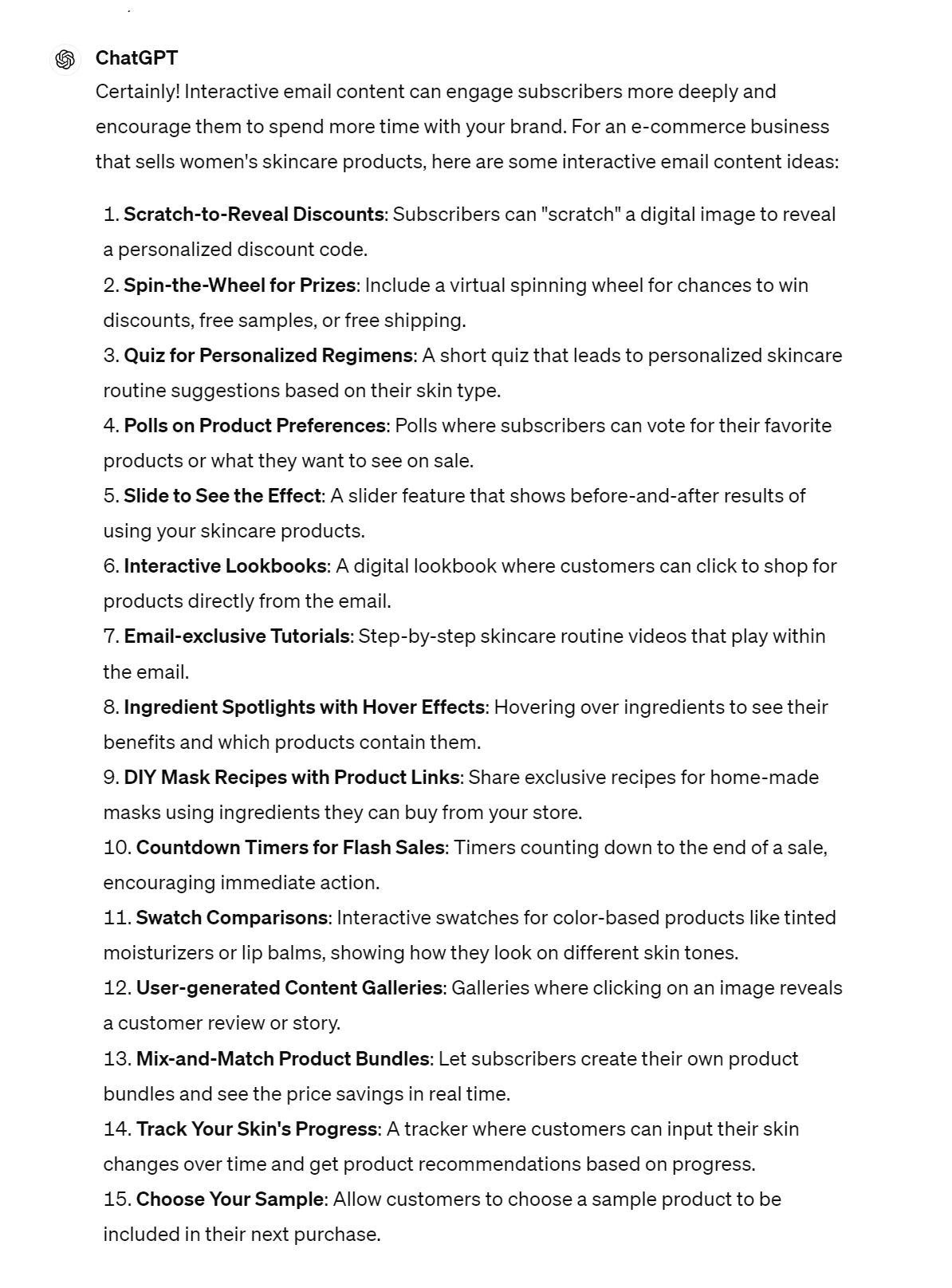
Prompt #3: Creative storytelling themes
Well-executed storytelling themes and narratives in email content can captivate your audience and leave lasting impressions about your brand.
Prompt: Create a list of creative storytelling or narrative themes for email marketing campaigns for [an eCommerce business that sells women’s skincare products].
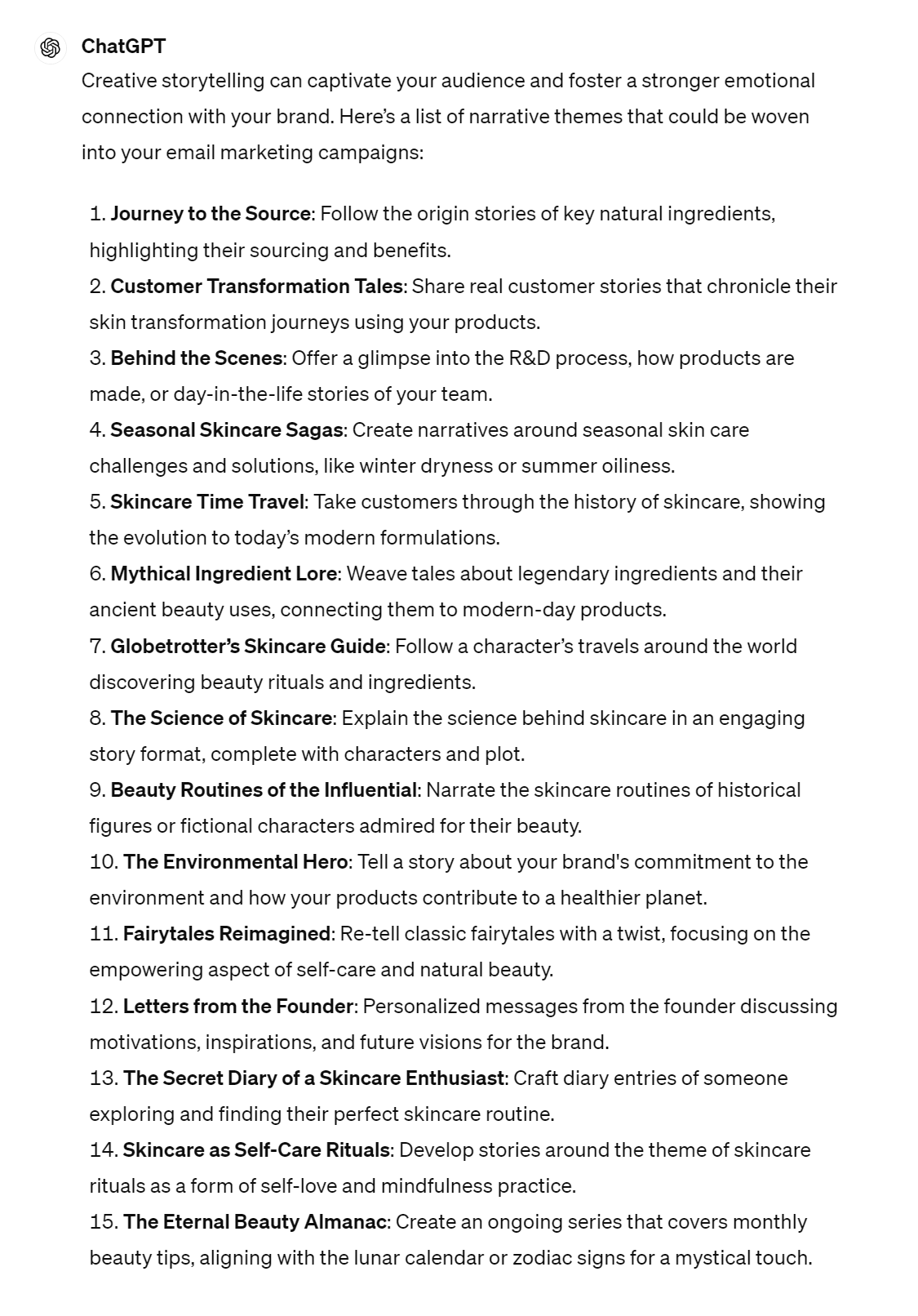
Prompts for Attention-Grabbing Subject Lines
The first thing your subscribers see when they receive your email is the subject line. It must grab the recipient’s attention or the graveyard for unopened emails will soon be welcoming a new arrival.
However, if you go too far the other way, your email is probably going to get caught by the spam filter. Let’s look at some prompts that help you craft effective subject lines that like increase your open rate and dodge the spam folder.
Here, we used a hypothetical SaaS business that provides human resources software for these prompts. Swap out the part in brackets for a description of your business.
Prompt #4: Emotional appeal subject lines
Our first type of subject line appeals to the recipient’s emotions, such as curiosity, excitement, or nostalgia, which are great for driving engagement.
When you use this prompt (and the others in this section), include the purpose of your email. We’ve chosen a promotional email newsletter for this one.
Tip: Ask for multiple options so you can easily A/B test your subject lines and have a variety of options to choose from.
Prompt: Give me 10 emotionally appealing email subject lines for [a promotional newsletter] for [my SaaS business that sells human resources software].
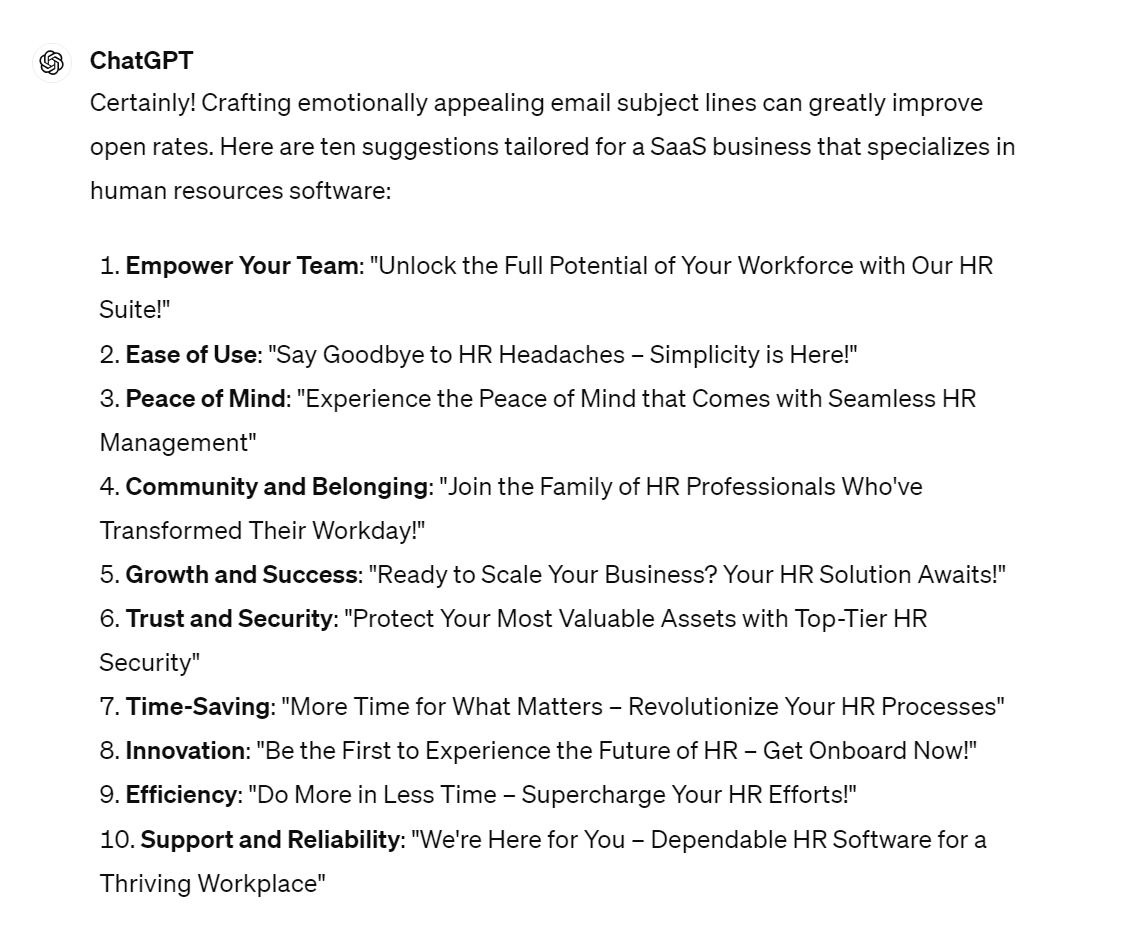
Prompt #5: Benefit-driven subject lines
A benefit-driven subject line highlights the value of opening the email by addressing the recipients’ needs or sparking interest in another way.
We tailored this prompt to a product launch email.
Prompt: Give me 10 benefit-driven subject lines for [a product launch email] for [a SaaS business that provides human resources software.]
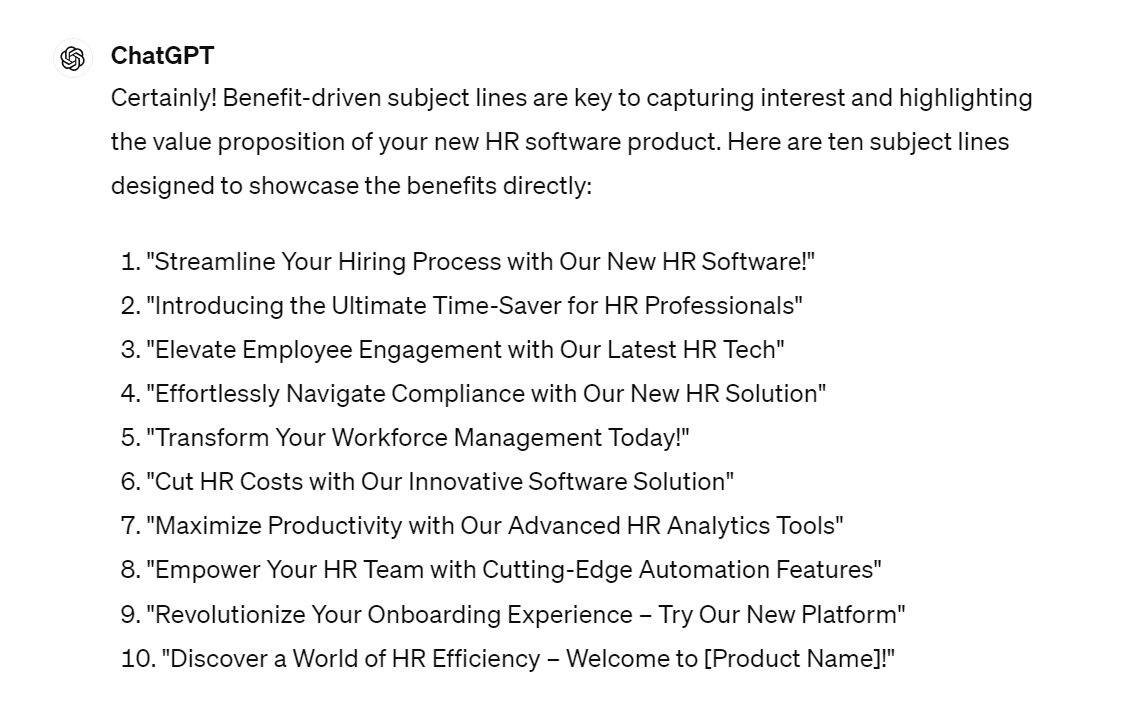
Prompt #6: Personalized subject lines
Personalizing your subject lines is a great way to improve your open rates. There are a few ways you can personalize them, from using the recipient’s name to referencing past purchase history.
This technique helps you create relevance and a sense of connection between your business and your customers.
We used a renewal reminder email for this prompt.
Prompt: Give me 10 personalized subject lines for [a renewal reminder email] for [a SaaS business that provides human resources software]. Leave blanks where I can add the recipient’s name or other personalization information.
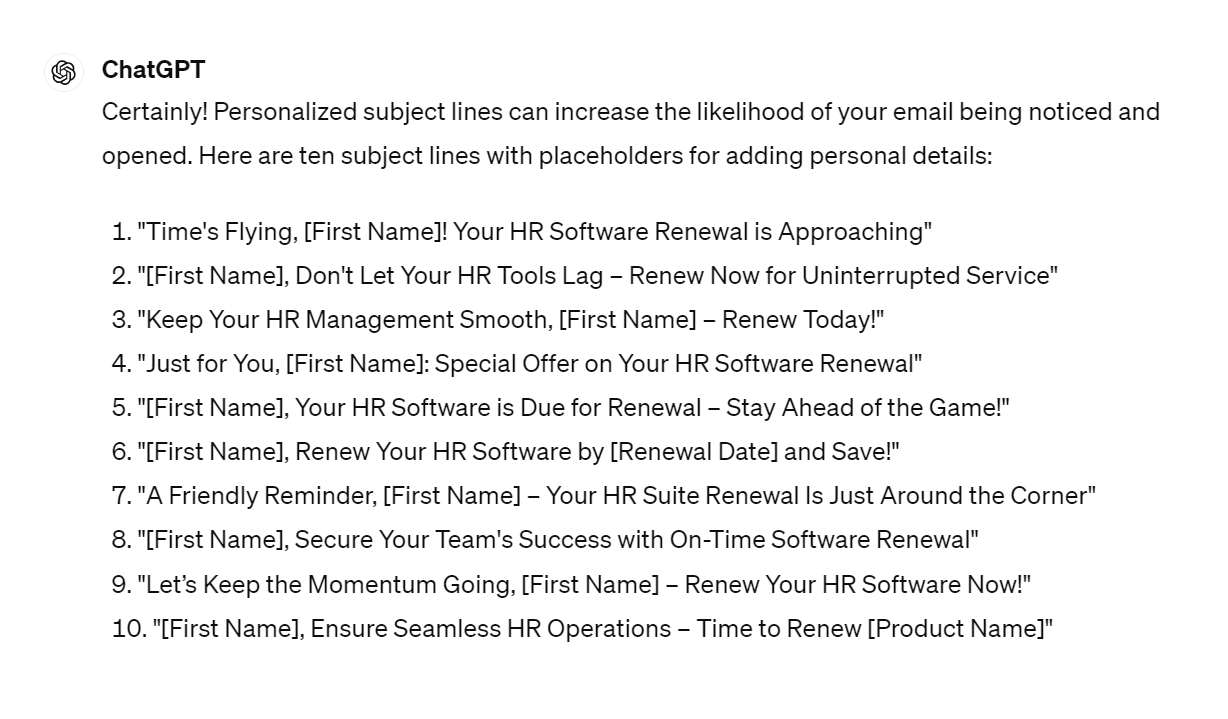
Prompt #7: Urgency and FOMO subject lines
Creating a sense of urgency and driving the “fear of missing out” (FOMO) is an age-old method of capturing a person’s attention, and it remains effective in email marketing.
Subject lines are a great place to start. You want to use a nice blend of time-sensitive language and limited-time offers or exclusive deals to drive your open rate and motivate immediate action.
However, you need to be extra careful to avoid “spammy” words here.
This method is ideal for emails promoting a sale, which is why we used it for our prompt example.
Prompt: Give me 10 subject lines that drive the sense of urgency for an email announcing a sale at [a SaaS company that sells human resources software]. Avoid any spam words.
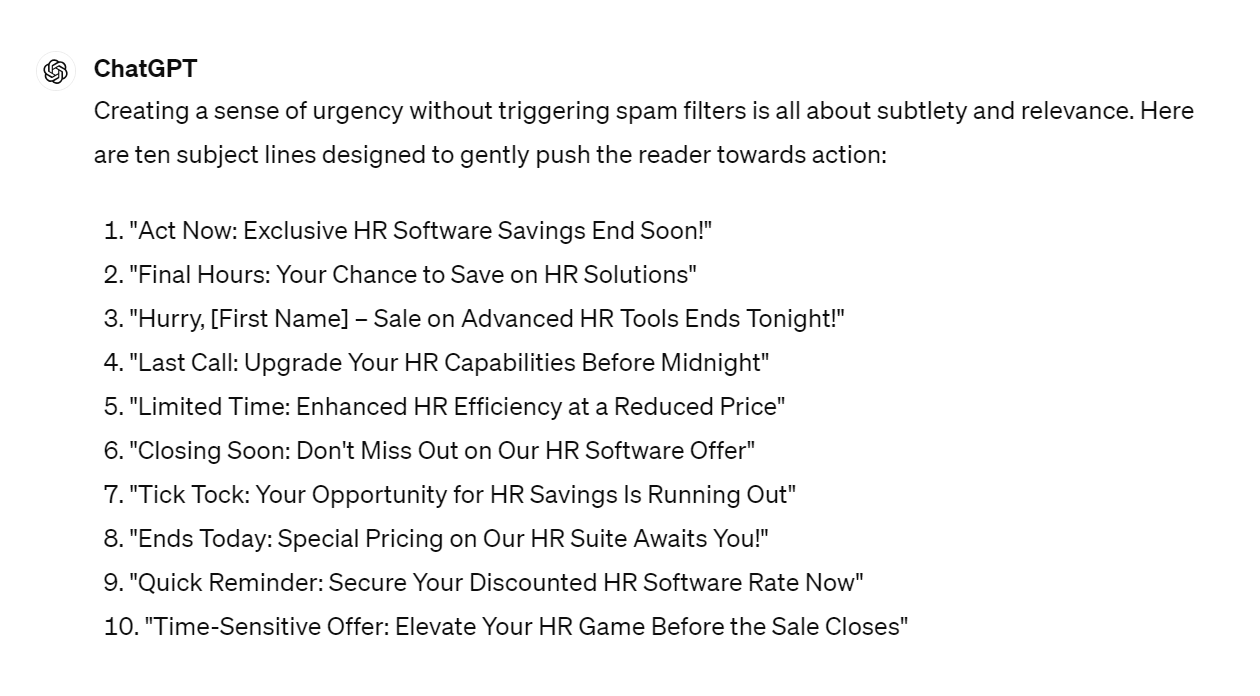
Need to check the quality of ChatGPT’s suggested subject lines? You can do that easily with a subject line tester. All you need to do is add the generated copy into a subject line testing tool, such as Refine, and see how your creation performs and what you can do to improve it.
Prompts for Compelling Body Copy
So, you caught the recipient’s attention, and they opened your email. Great! Now, you need to keep them engaged and drive them toward conversion, encouraging them to take a desired action, such as purchasing online or visiting your store.
That’s why you must craft compelling, engaging body copy for your emails. And ChatGPT can help speed up your email copywriting.
Prompt #8: Storytelling narratives
In our first section, we showed you how to prompt storytelling narrative ideas. A narrative theme throughout your body copy is an excellent way to keep your audience engaged, and when done well, should provide you with plenty of opportunities to link back to the products or services your business offers.
For this prompt, we chose one of the narrative ideas from our first section.
Prompt: Write [200-300 words] for the body copy of a creative storytelling email from [an eCommerce business that sells women’s skincare products]. The theme is [empowering confidence, focusing on how skincare contributes to confidence and self-expression]. Emphasize the role of my business’s products in [enhancing natural beauty]. Leave blanks where I can tie it back to products in my store.
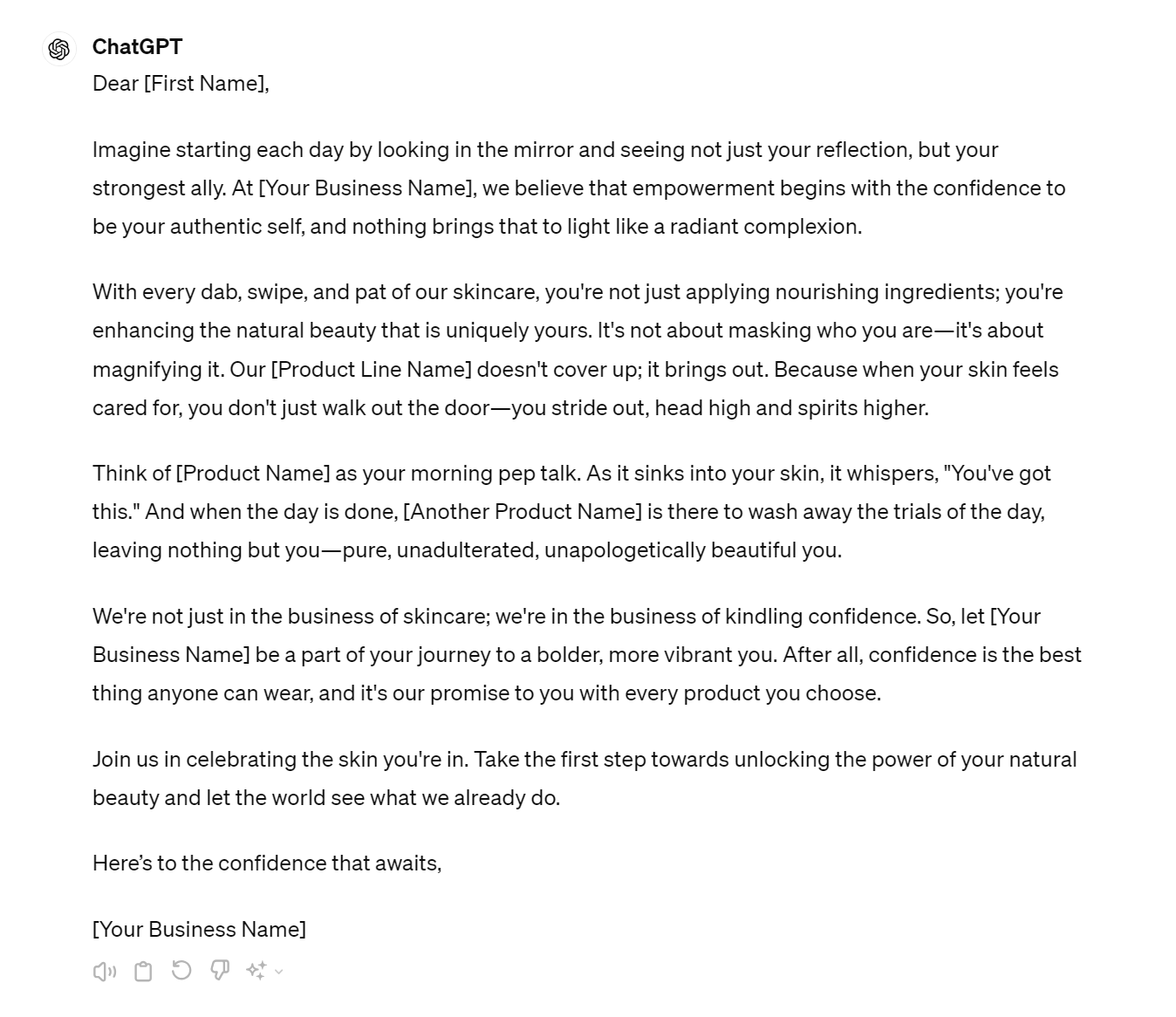
Prompt #9: Problem-solution frameworks
A problem-solution email identifies customer pain points and presents your product or service as the answer. It’s an effective tactic to add to your email marketing efforts as it showcases how your product or service addresses the readers’ needs.
Prompt: Write [200-300 words] for the body copy of a problem-solution framework email for [a SaaS business that sells human resources software]. Leave blanks where I can tie it back to [services the software offers]. Create a subject line and preview text as well.
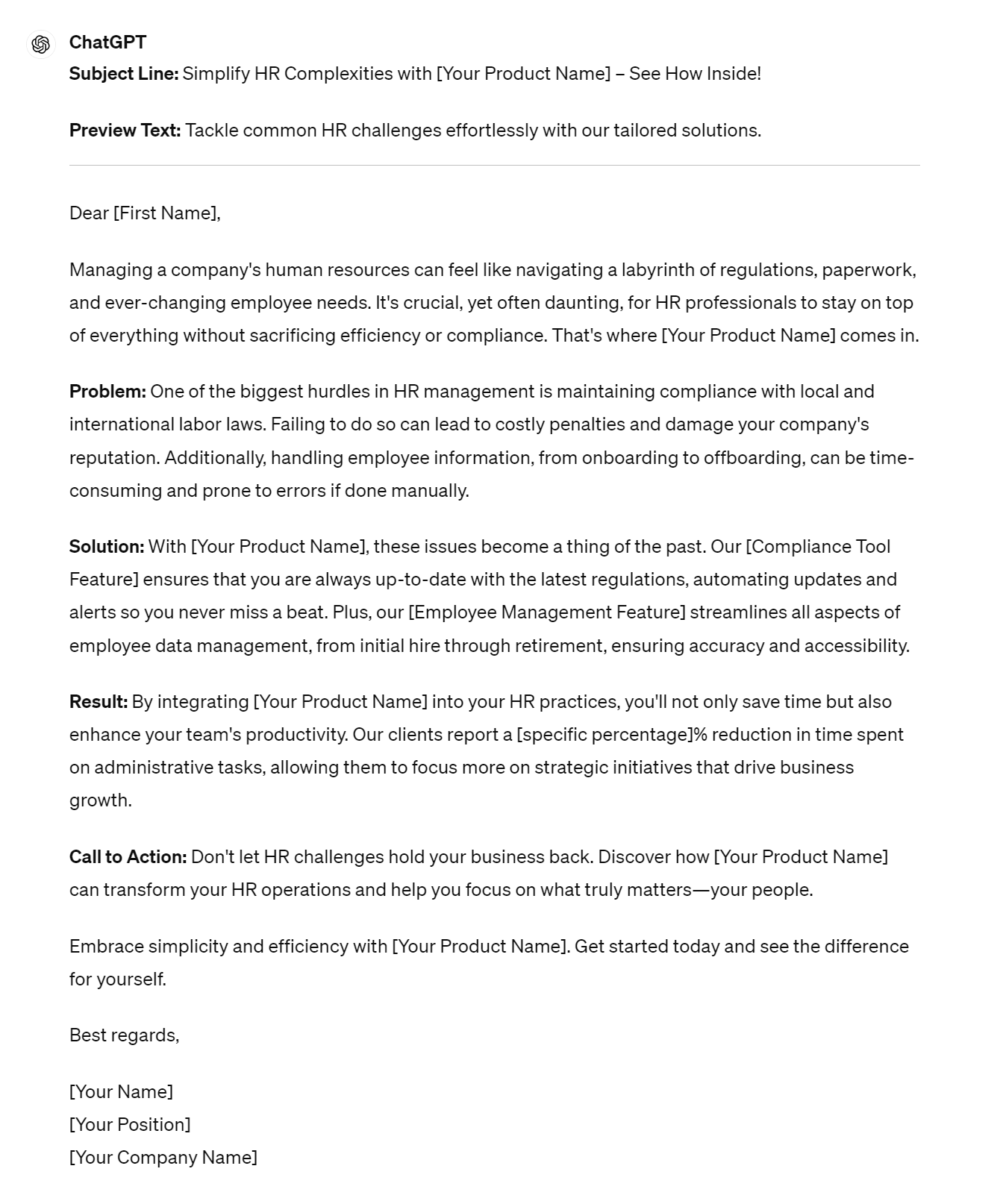
Prompt #10: Social proof integration
Social proof is an excellent tool in digital marketing because it showcases your customers’ success stories. People are more willing to sign up for a service or make a purchase when they can see how it has helped others.
Incorporating social proof, such as testimonials from satisfied customers and reviews from reputable review sites, on your website or social media channels like LinkedIn and Instagram, will help you establish credibility and trust. Plus, it will give potential shoppers valuable insight into how well your product/service works.
Prompt: Give me five ideas for integrating social proof into my email copy for emails from [an eCommerce business that sells women’s skincare products].
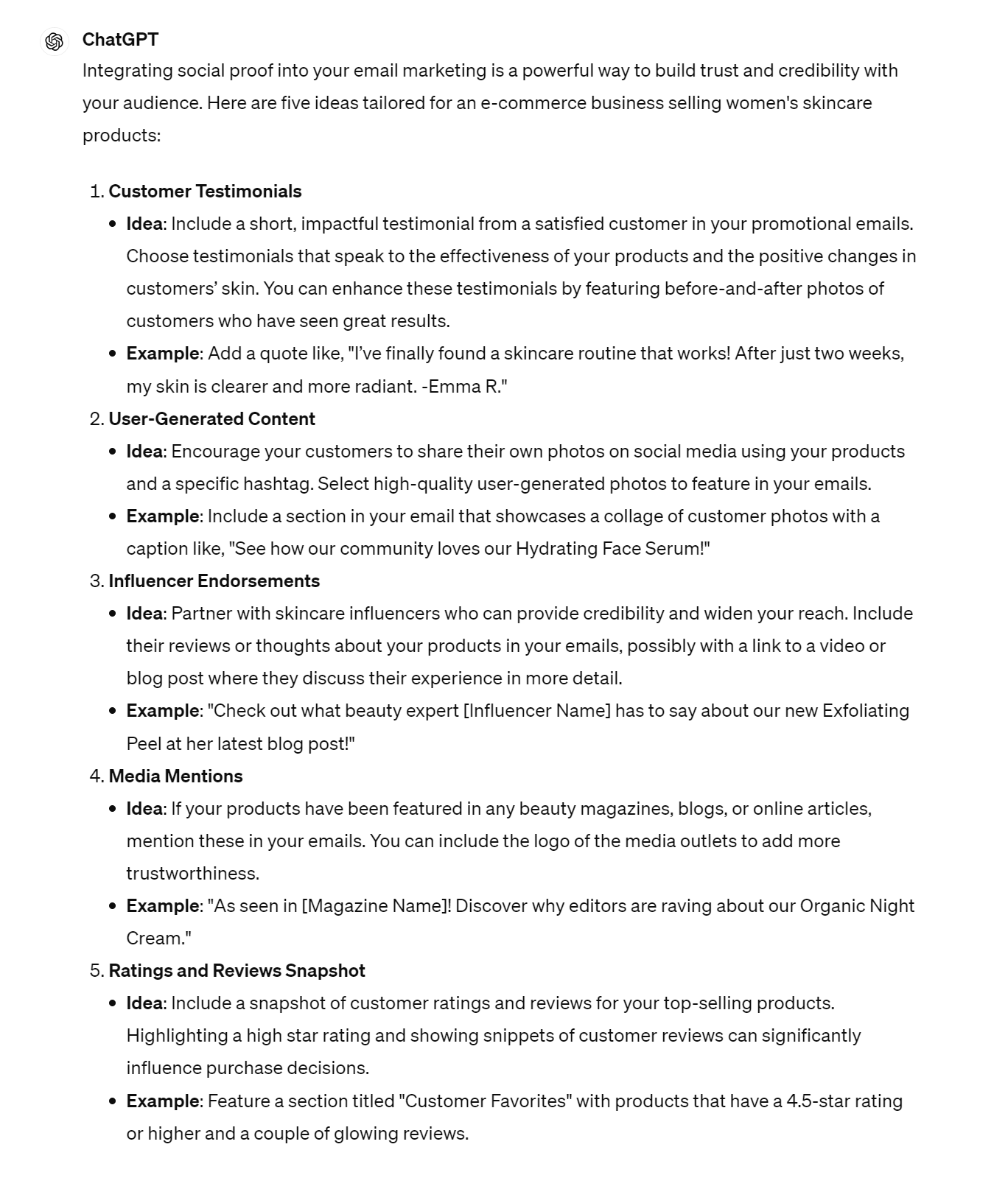
Prompt #11: Call-to-action formulations
Persuasive CTAs encourage your subscribers to take the desired action, like making a purchase, signing up for an event, or downloading a resource.
While your email’s body copy will keep them engaged and lead them toward an action, the CTA is the final element that will either convince them to click or let them scroll past.
CTAs should be strategically placed throughout your email copy, following any particularly strong selling point, and can take the form of text links or buttons, depending on the design of your email.
Prompt: Write 10 compelling and persuasive CTAs for the body copy of an email from a [SaaS business that sells HR software].
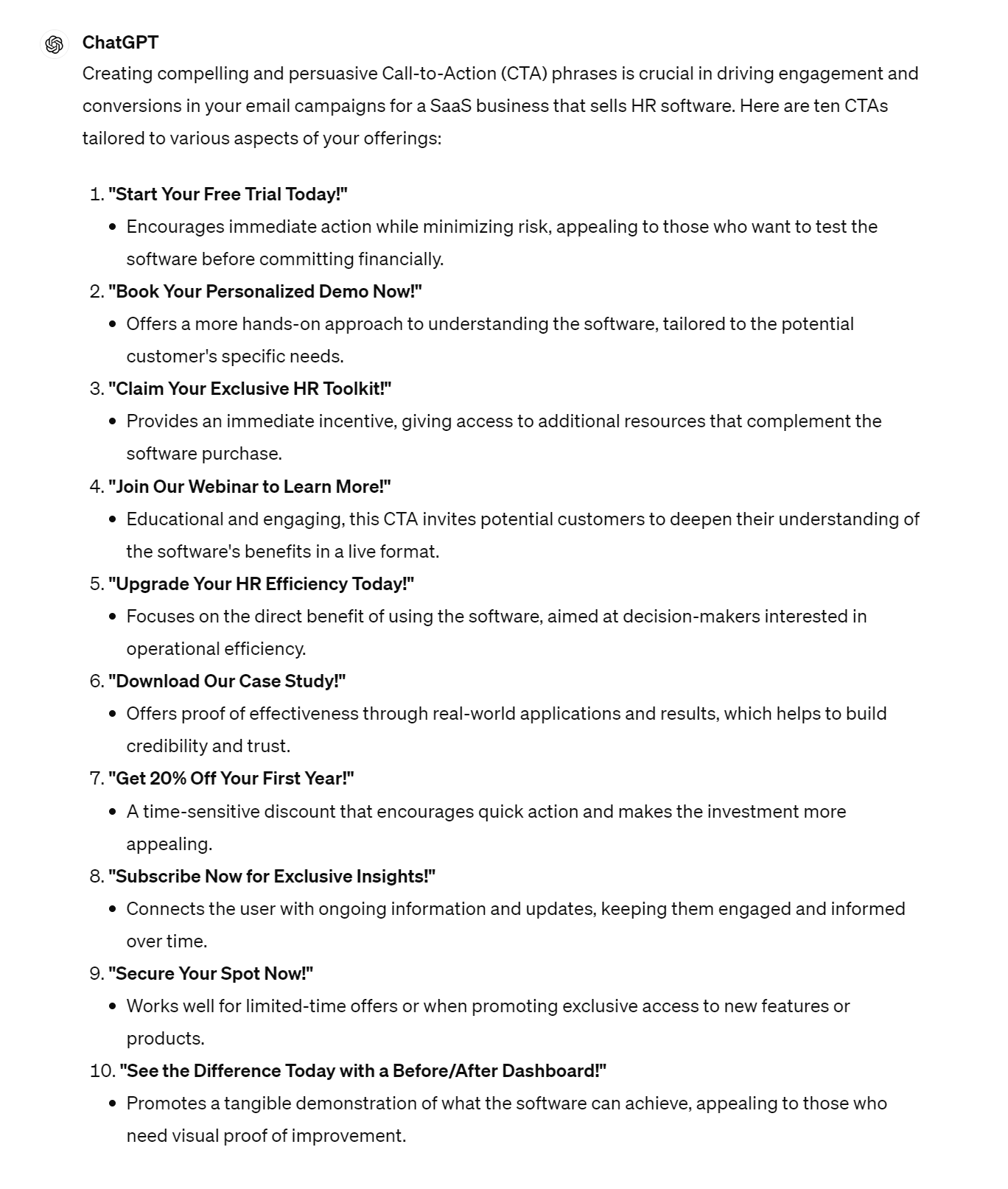
Prompts for A/B Testing Strategies
A/B testing is a vital part of content marketing, but coming up with variations to trial can be tedious. One of the best uses of ChatGPT is creating variations in parts of an existing piece of content, such as the subject line, or generating new alternative content from scratch.
Use the prompts below to assist your A/B testing strategy.
Prompt #12: Subject line variations
Testing different variations of your subject lines is essential for finding the one that best resonates with your target audience and gives you the highest open rates.
You can try out different lengths, tones, levels of personalization, and urgency, and see which combination works best for your audience’s needs.
Prompt: Give me 10 variations of the subject line “Exclusive Offer for [Company Name]: Renew Your HR Software Now!” for A/B testing. Use different lengths, tones, personalization, or urgency.
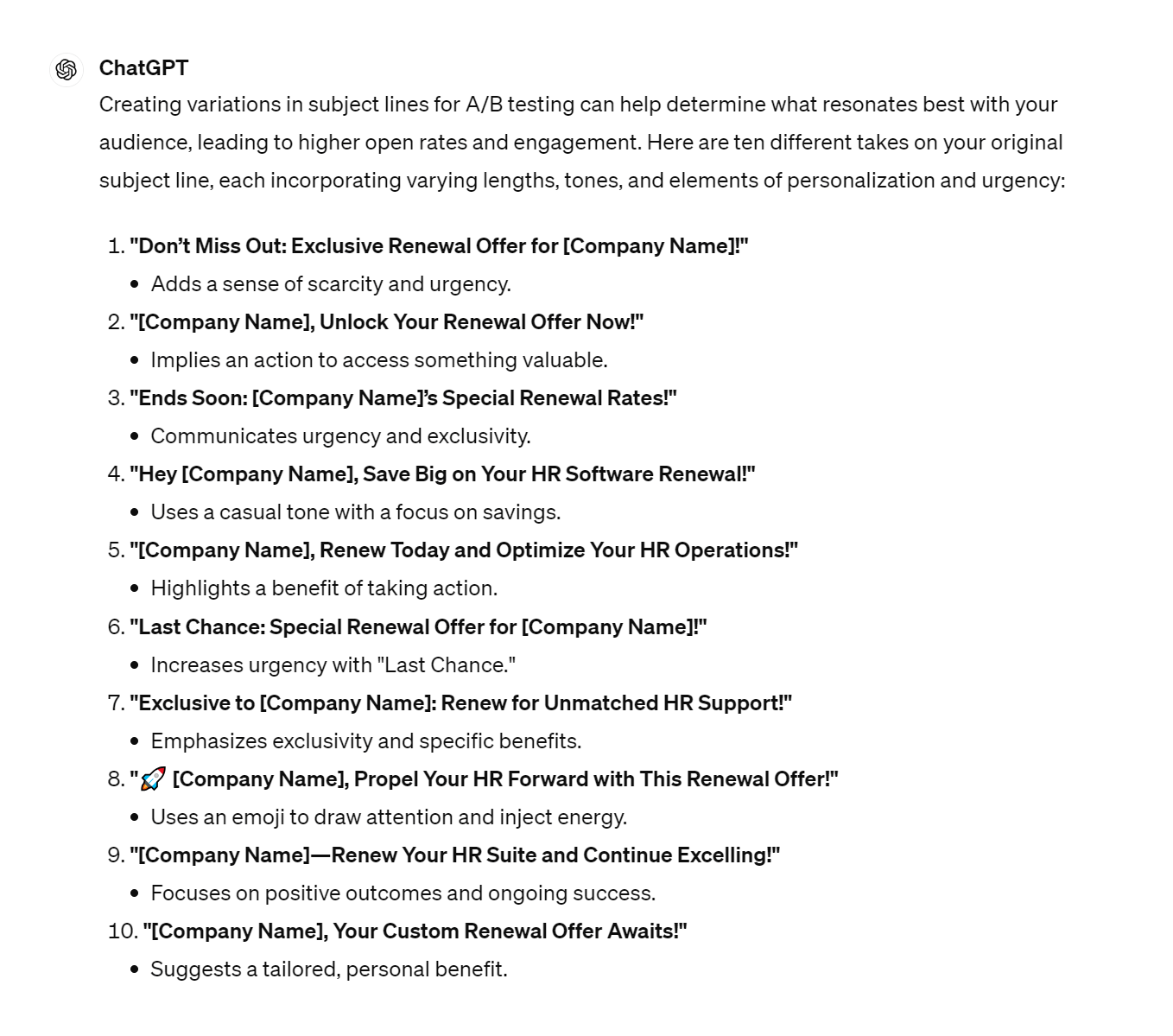
Prompt #13: Visual content testing
Keeping the visual content in your emails fresh and appealing while staying on-brand is crucial in your email marketing campaigns. It’s also important to test variations of visual content if you notice your click-through and conversion rates are less than desired.
ChatGPT can provide some ideas for variations, and if you get the premium version and access OpenAI’s image model, DALL-E, you can even generate the images it suggests.
Keep in mind, though, that AI-generated images are prone to having inconsistencies that will not leave a great impression. If you want to avoid going viral for the wrong reasons, consider using AI-generated images as a blueprint or inspiration for your design team.
Prompt: Provide five variations of visual elements for A/B testing in an email from [a women’s skincare eCommerce store]. Include variations of images, graphics, colors, or layout.
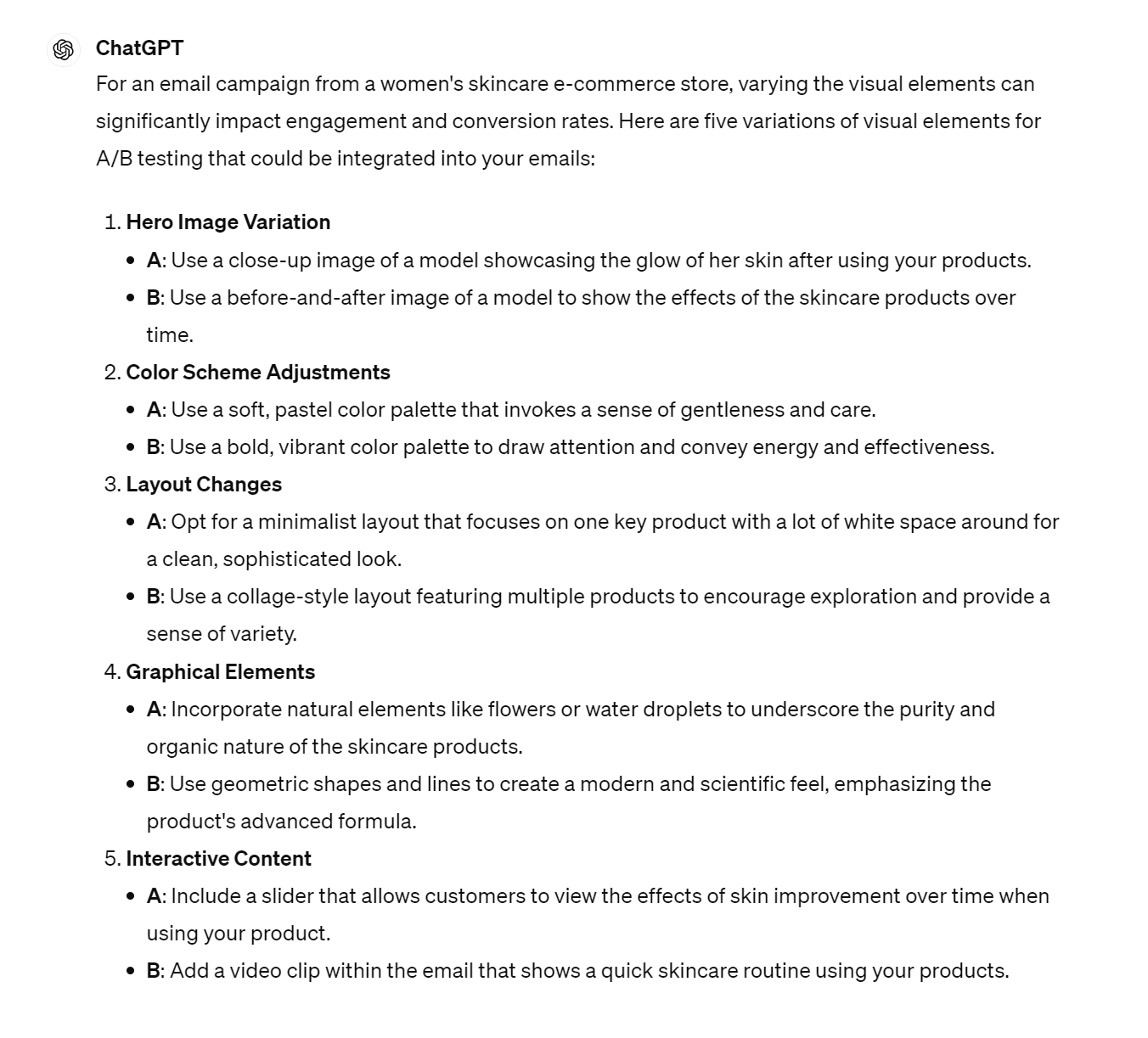
Prompt #14: Call-to-action optimization
Click-through rate lacking? You might want to try some different CTA variations. There are several CTA elements you can change to see which ones work best for your audience, and ChatGPT can help you generate new ideas for CTA A/B testing.
Prompt: Provide 5 variations of a call-to-action in an email for A/B testing. Include different copy, placement, color, size, and design.
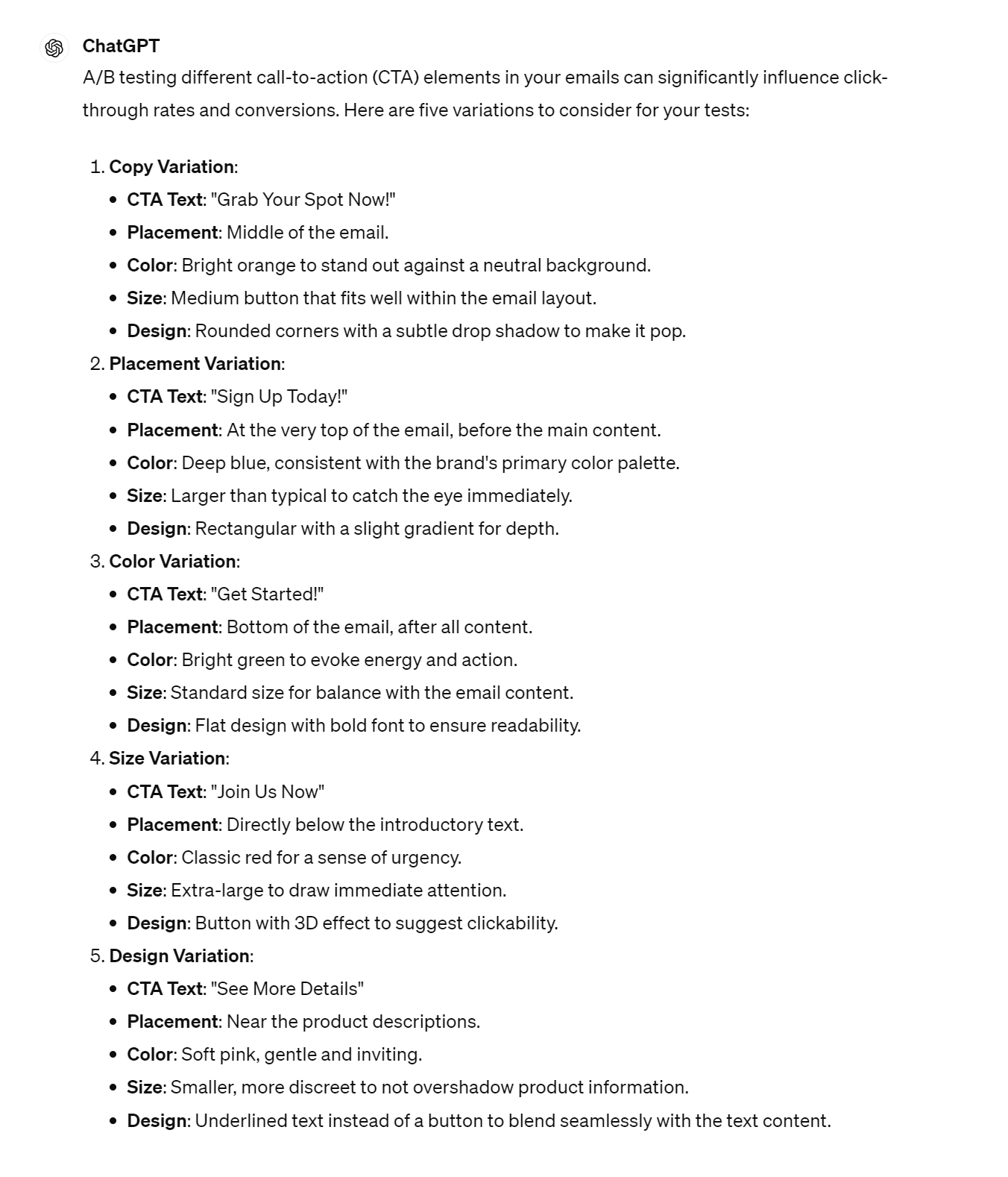
Prompts for Segmentation Strategies
Members of your audience will have different needs, so sending them all the same email content is a waste of time and resources. You need to segment your audience if you want to send email content tailored to each subscriber’s needs.
Let’s look at some prompts that can help guide you in your segmentation efforts.
Prompt #15: Demographic segmentation
The first segmentation method is based on demographic factors, such as age, gender, location, income level, or occupation. You can also get really niche with demographic segmentation and use factors specific to your business, like “teenage girls who struggle with acne” or “hiring managers at startups.”
Prompt: Provide guidance on how to identify relevant demographic factors and create targeted segments for email marketing campaigns for [an eCommerce business that sells women’s skincare products].
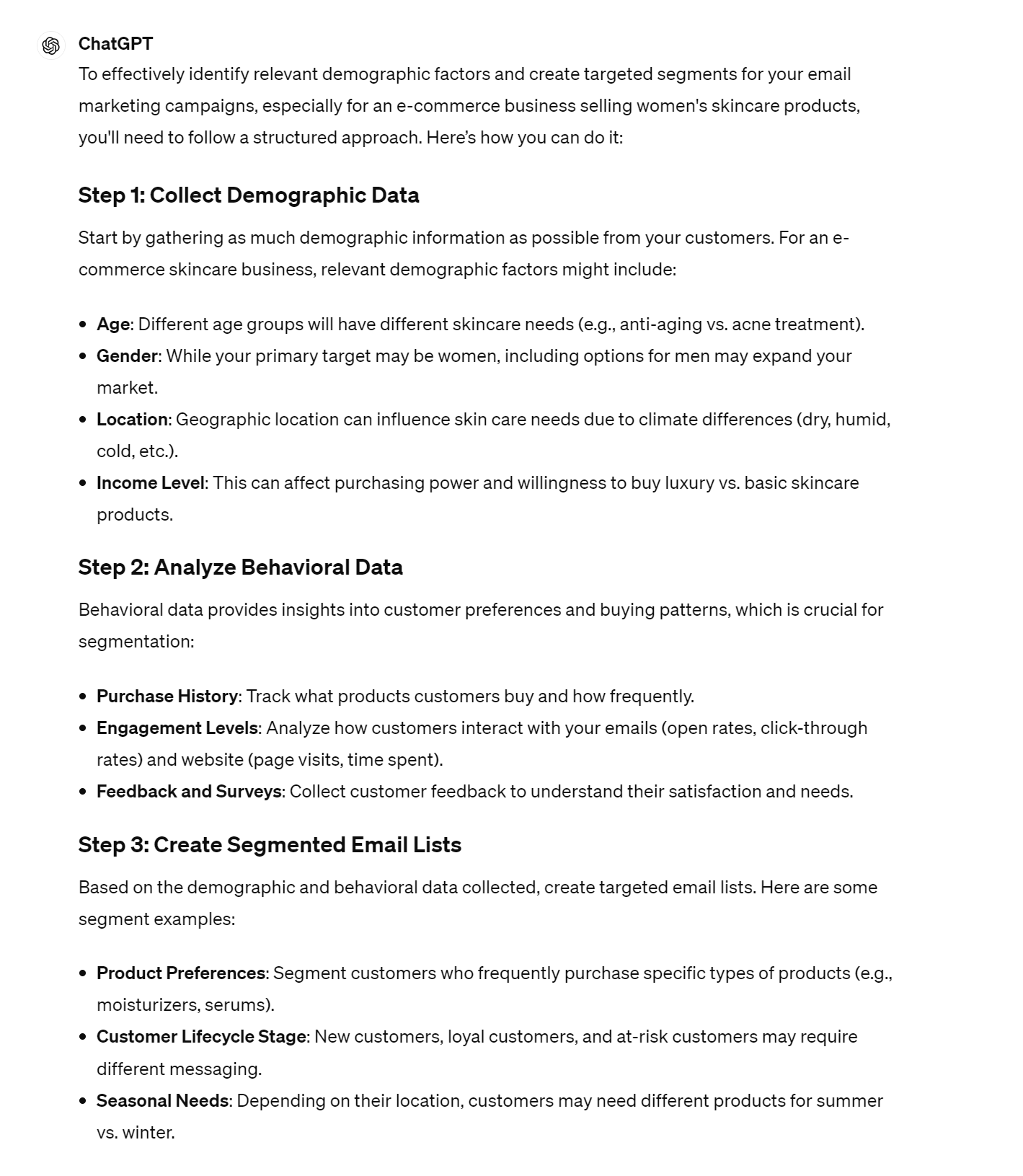
Prompt #16: Behavioral segmentation
Just because two people are in the same demographic doesn’t mean they will interact with your business in the same way. That’s why segmenting your audience by behavior is also beneficial.
This is especially helpful when you want to send cross-selling emails based on past purchases or browsing history, abandoned cart emails, and many other types of targeted emails.
Prompt: Provide guidance on identifying and segmenting my email list by behavior for email marketing campaigns for [a SaaS company that provides HR software].
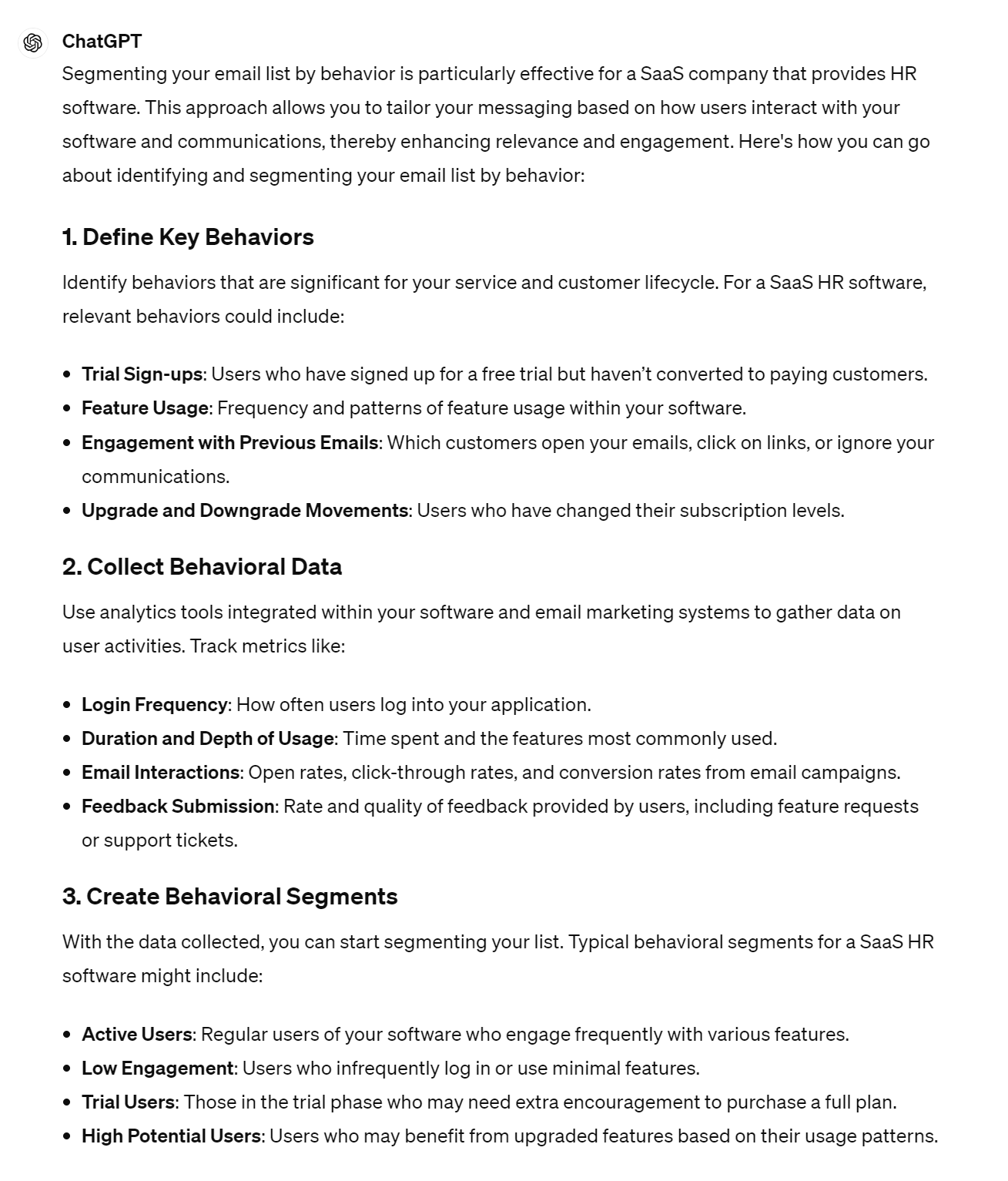
Prompt #17: Customer journey segmentation
Sending the same content to both a loyal customer of several years and a new subscriber isn’t the right approach. Both customers have different needs as they are at various stages of their customer journey or life cycle.
This method of segmenting your email list can be beneficial for sending re-engagement emails to churned customers and those who haven’t purchased in a while.
Prompt: Provide guidance on identifying and segmenting my email list by customer journey for [a SaaS company that sells HR software].
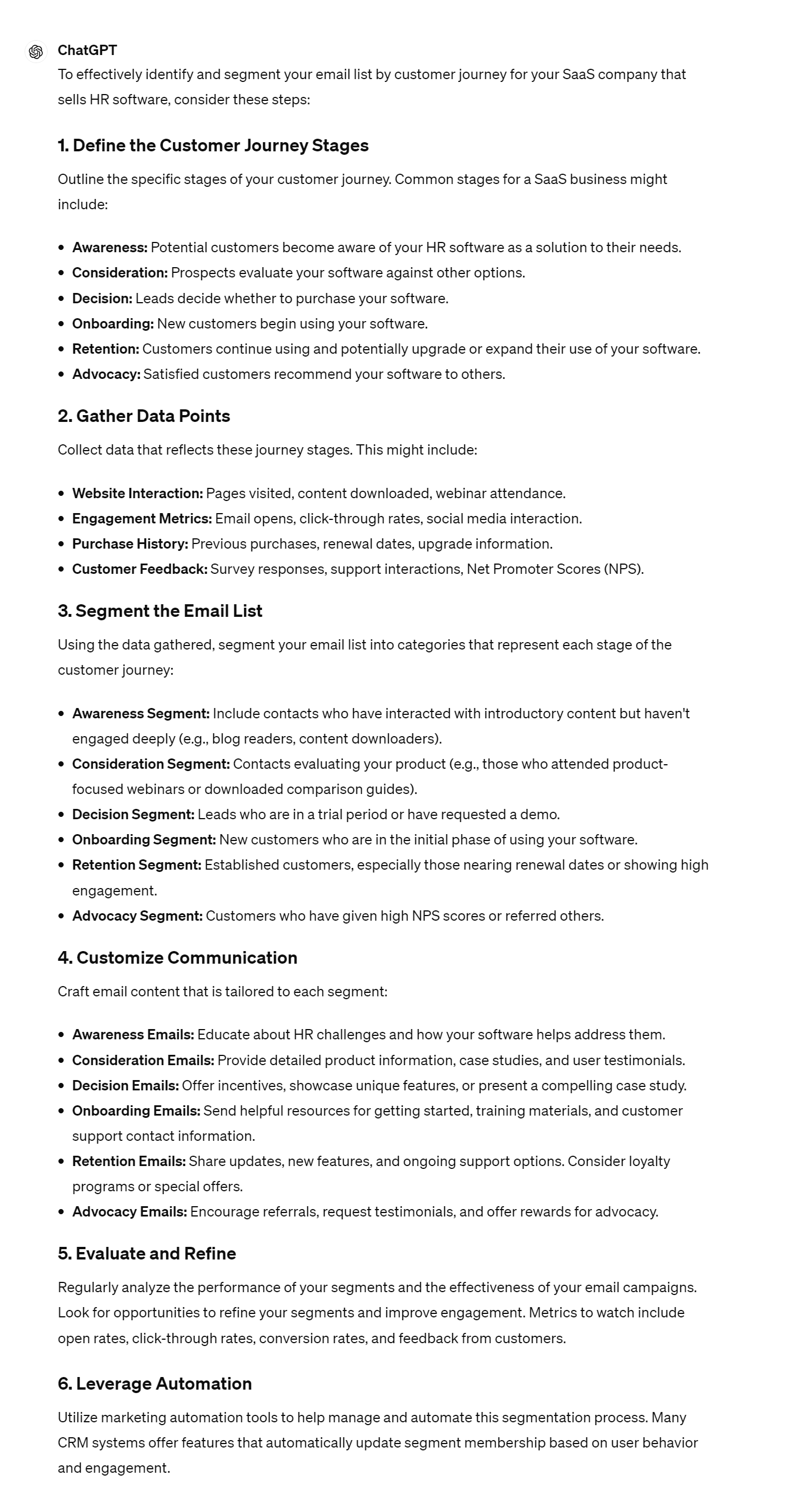
Not sure how to get started with segmentation and automation?
Platforms like Moosend will give you all the tools you need to segment your audience based on the above criteria and more. Moreover, the workflow builder is both intuitive and user-friendly, giving you numerous triggers and actions to send the right content at the right time.
Prompts for Building Your Email List
Your email list is essentially a living entity that should always evolve, with new email addresses being added daily and unengaged ones being removed when you clean your email list.
If you want to continually grow your list, there are a few strategies you can implement, and ChatGPT can help you plan and optimize them.
Prompt #18: Lead magnet creation ideas
A lead magnet is an excellent way to generate new emails for your list. It can take many forms, from a downloadable resource to a giveaway entry.
Prompt: Generate 10 lead magnet ideas for growing the email list of [an eCommerce business that sells women’s skincare products].
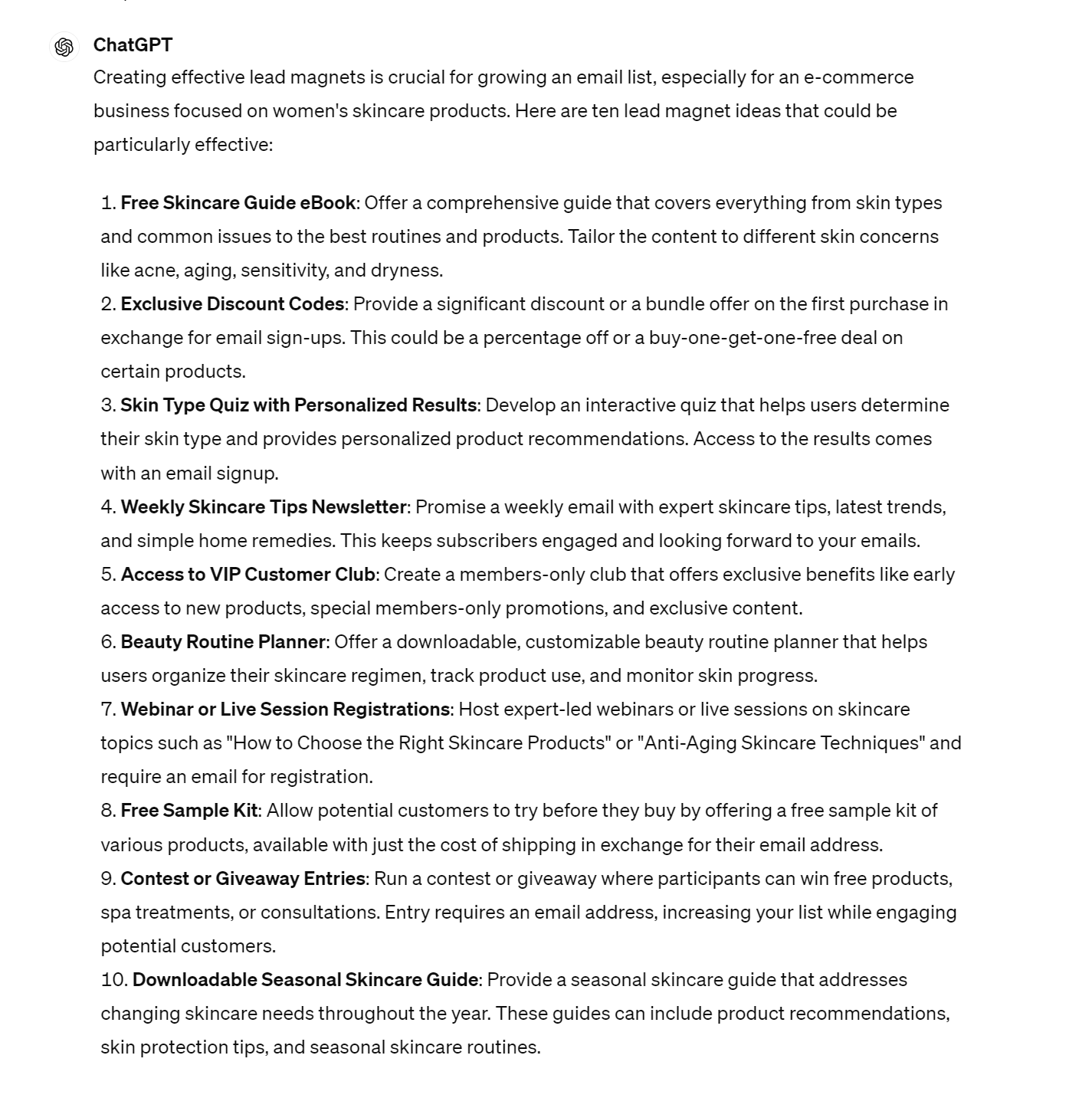
Prompt #19: Opt-in form optimization
An opt-in form on your website is a great way to capture the emails of potential customers. However, if you find your form isn’t working so well, it may be time to optimize it. Use the prompt below to come up with optimization strategies.
Prompt: Guide me on opt-in form optimization for growing my email list.
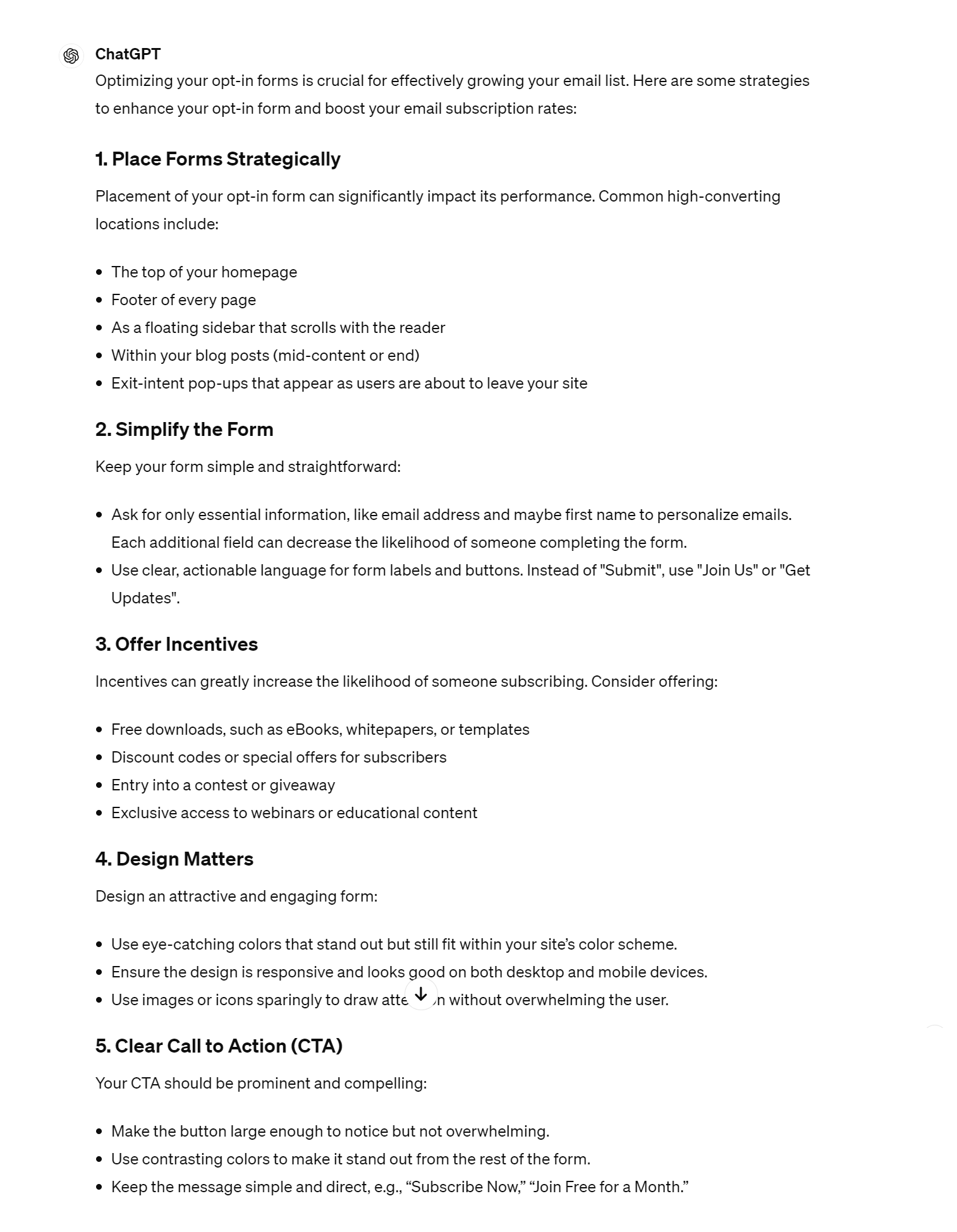
Additional resources
Here are a few resources to help you design and plan your signup process more effectively:
Prompt #20: Social media integration strategies
A robust social media strategy is vital for every business today, and it has many applications beyond the obvious. One of those is assisting in growing your email list, and the following prompt can help you find new ideas to integrate the two channels.
Prompt: Guide me on integrating my email list growth efforts with social media platforms, including strategies for leveraging social media ads, contests, giveaways, or exclusive offers to encourage followers to subscribe to the email list.
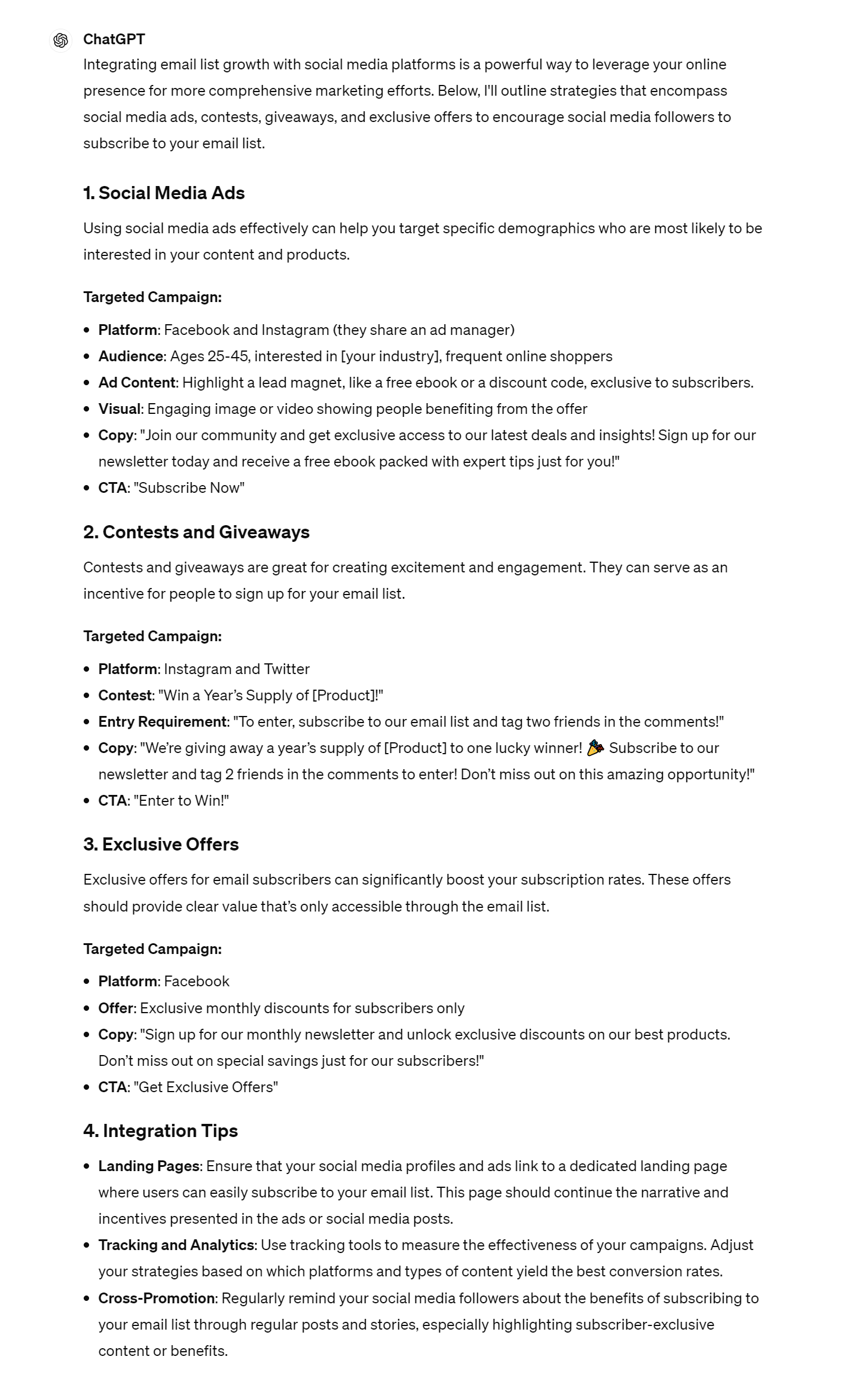
Additional resources:
- Facebook Lead Ads: In-Depth Guide
- Instagram Giveaway Ideas
- TikTok Marketing: A Marketer’s Roadmap
- How To Use Snapchat For Business [Beginner’s Guide]
Prompts for Email Design and Optimization
Designing your email campaigns isn’t just a matter of making them look pretty. Many elements contribute to an appealing, on-brand email design, from visual branding to photography, layout, and CTAs.
Prompt #21: Visual branding strategies
First, ensure a cohesive, on-brand visual identity across all your email campaigns. This includes your color schemes, branding (logos, slogans), typography, imagery, and more.
Ensuring cohesion and consistency is vital.
Prompt: Guide me on visual branding strategies for my email marketing campaigns, including color schemes, logos, imagery, and typography, to maintain brand consistency.
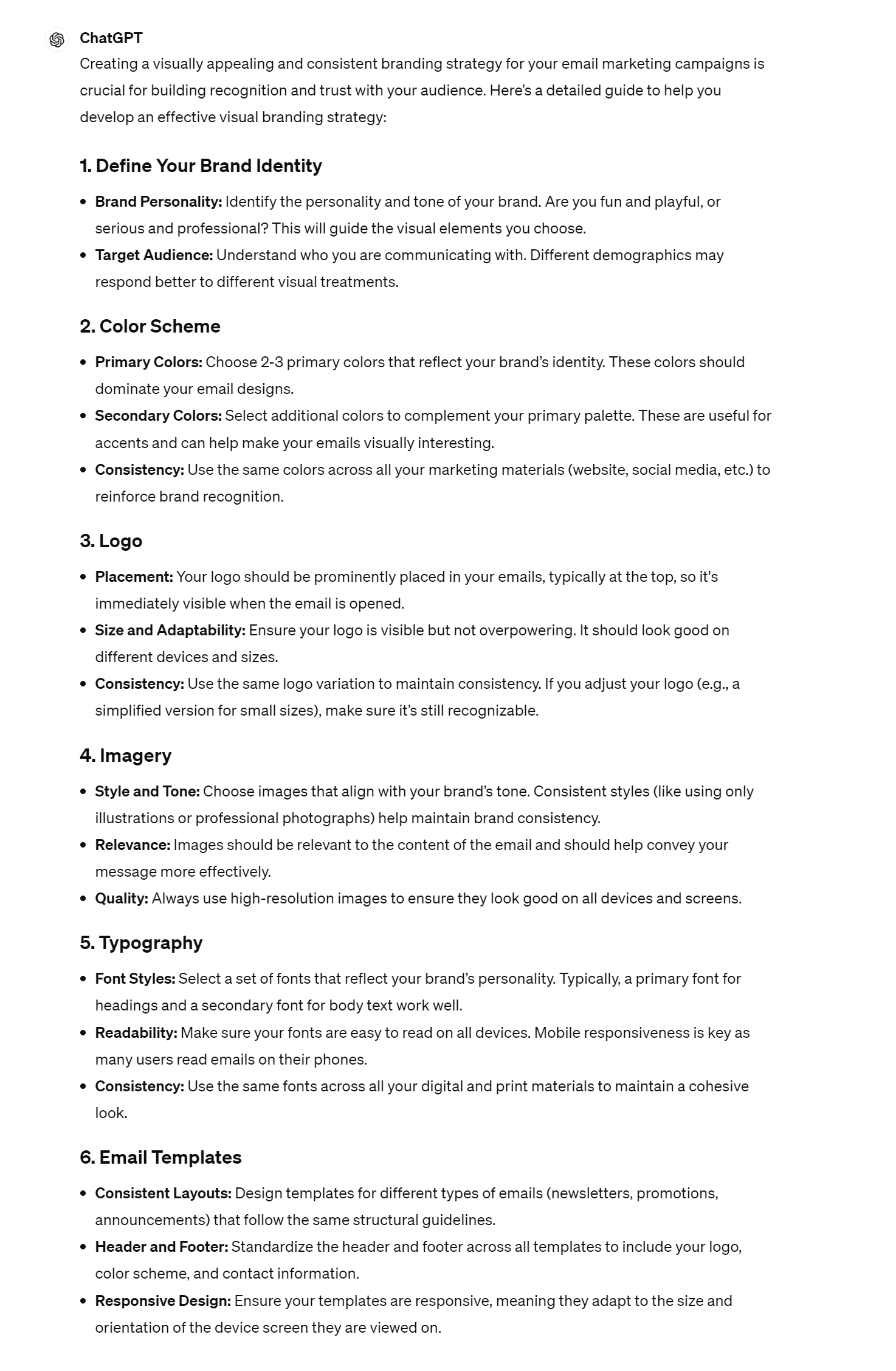
Prompt #22: Layout and format optimization
While aesthetic appeal in email design is essential, you shouldn’t neglect the layout and format of your campaigns. Paying attention to content hierarchy and having a balanced text-to-image ratio are essential for effective communication and engagement.
Prompt: Guide me in optimizing my email layout and format, including email length, text-to-image ratio, whitespace utilization, and hierarchy of content elements, to improve readability, engagement, and click-through rates for email campaigns.
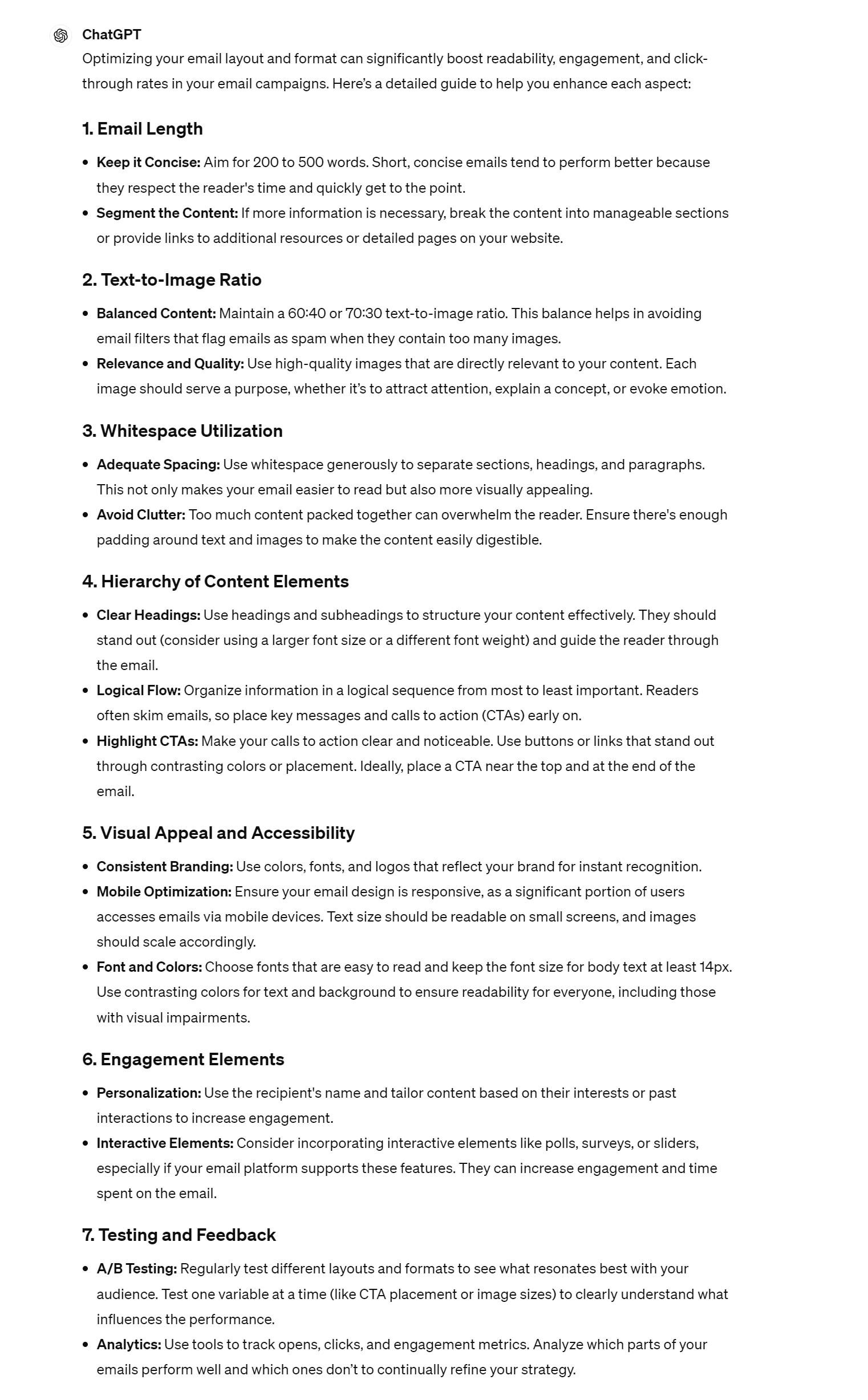
Prompt #23: CTA design and placement
We’ve already mentioned how vital CTAs are as they drive your click-through and conversion rates. So, you want to ensure they’re well-designed and placed to capture as much attention as possible.
Here’s a prompt to do just that.
Prompt: Give me ideas for optimizing my email CTAs, including CTA button design, copywriting strategies, placement, size, color, and contrast, to drive click-throughs and conversions effectively.
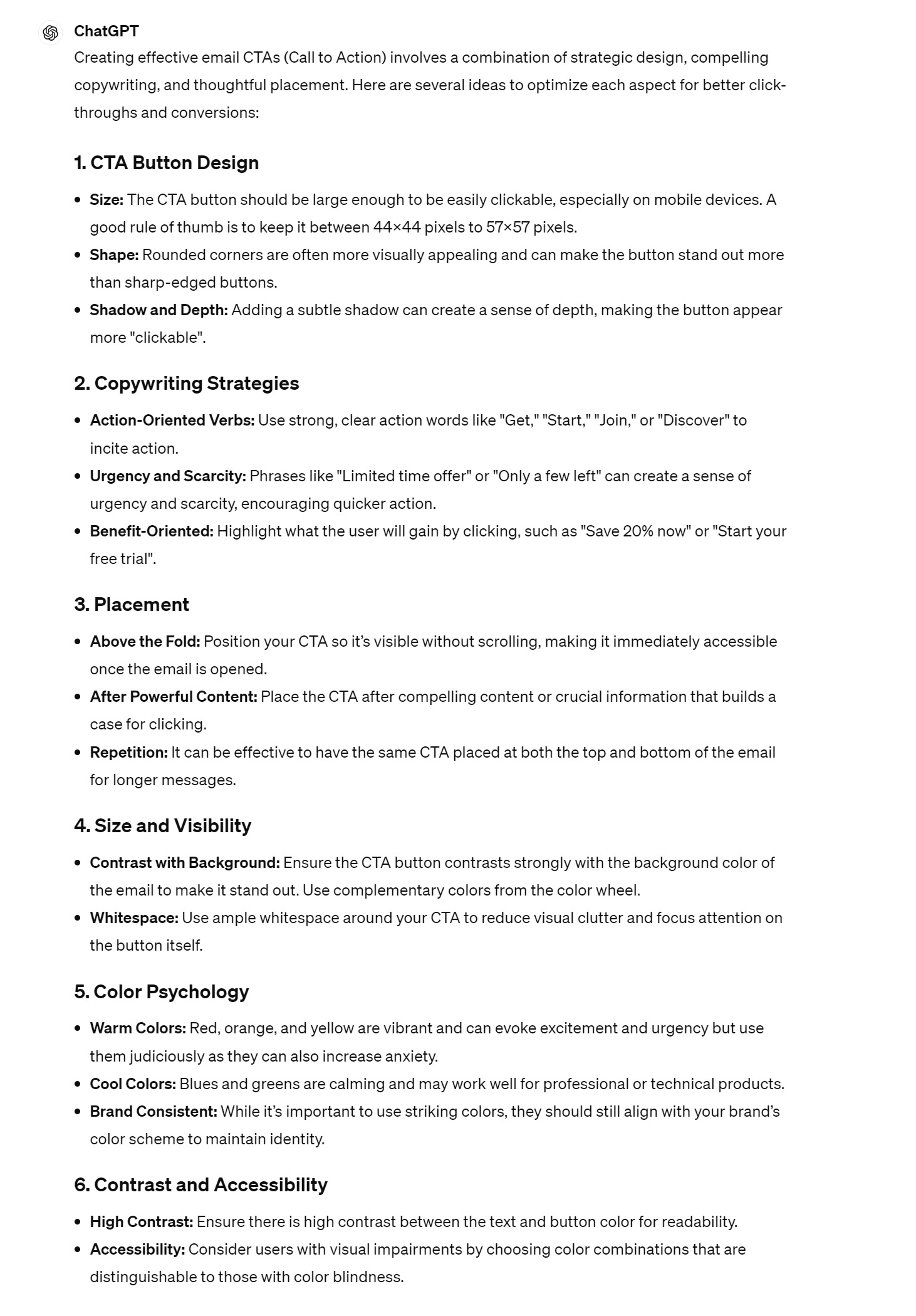
Prompts for Compliance Assistance
Now your email campaign is ready to go. You’ve optimized the body copy, subject line, and visuals, targeted it to a specific audience segment, added personalization, and even set up variations for A/B testing.
Before you send it, however, ensure that your email campaign complies with relevant email marketing regulations, including the GDPR, CAN-SPAM, and CASL.
ChatGPT can help here, too.
Prompt #24: GDPR compliance guidance
The General Data Protection Regulation (GDPR) governs the collection, processing, and storage of personal data for individuals within the European Union.
There are several key points to consider to ensure your email marketing efforts remain compliant. The prompt below will provide a refresher if needed.
Prompt: Guide me on GDPR compliance for email marketing strategies.
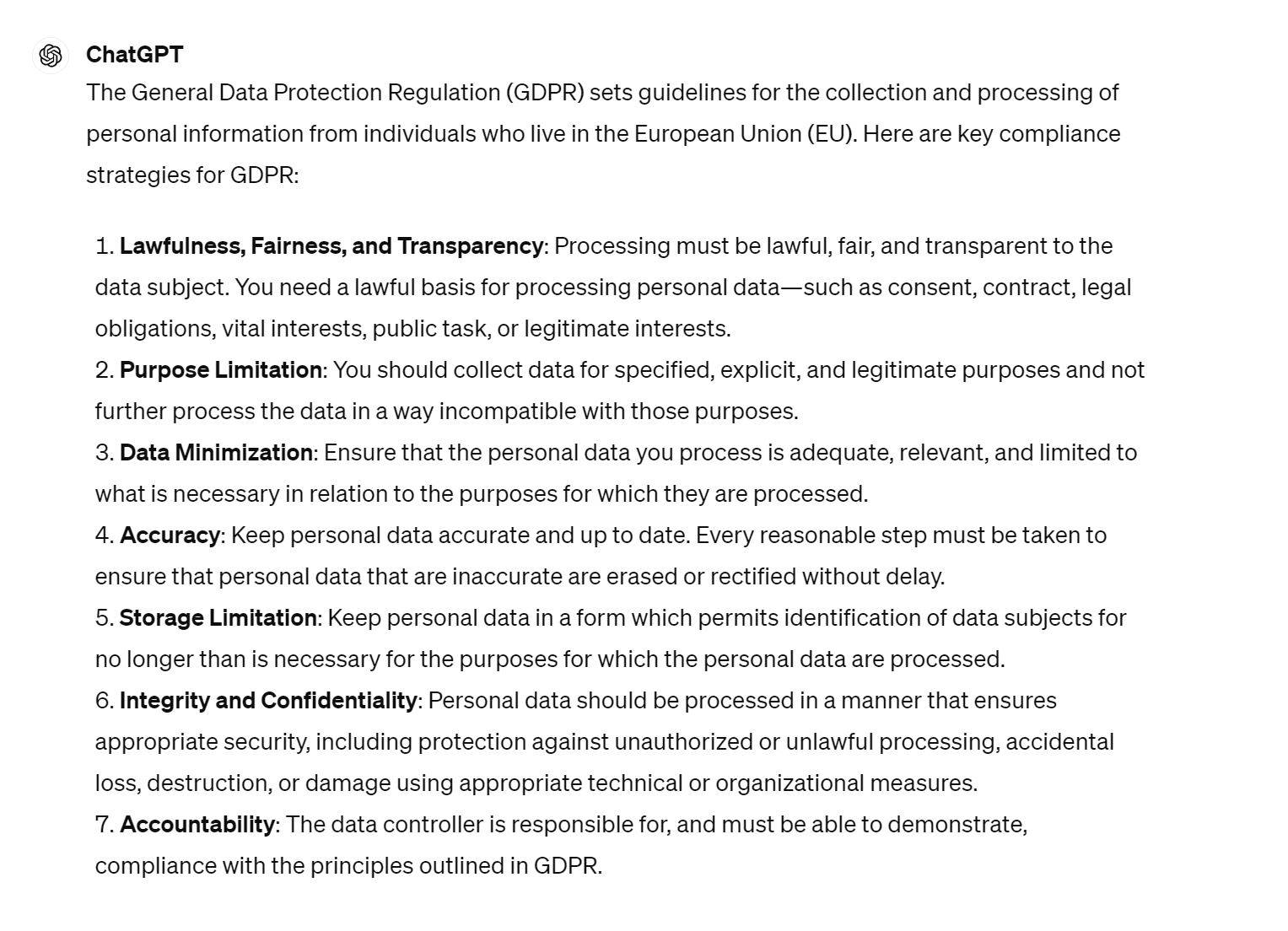
Prompt #25: CAN-SPAM Act compliance tips
The CAN-SPAM Act of 2003 is a law that governs email and commercial messaging within the United States.
You can use the following prompt to ensure your email campaign’s compliance with the act.
Prompt: Guide me on CAN-SPAM compliance for email marketing strategies.
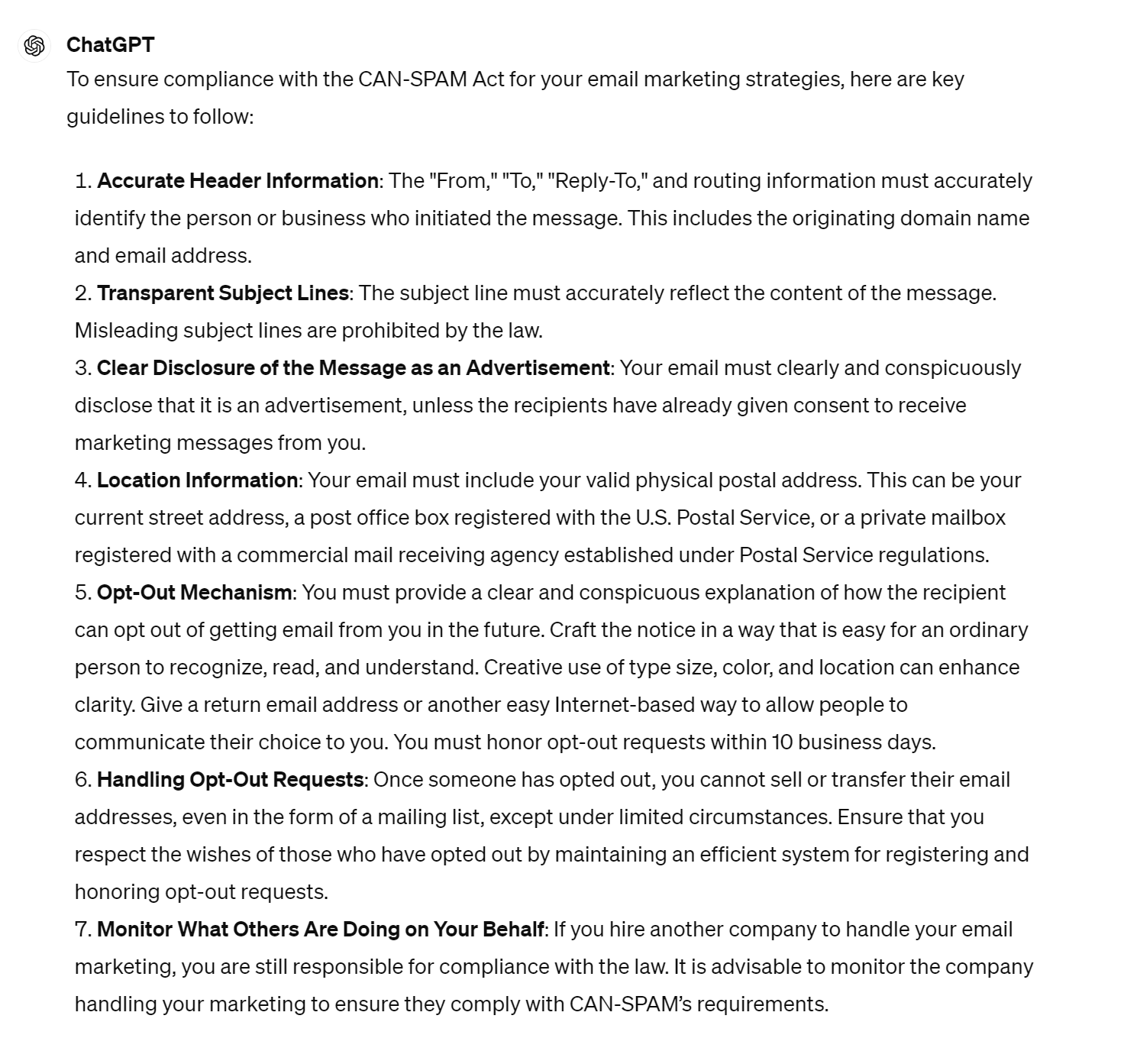
Prompt #26: CASL compliance strategies
The Canadian Anti-Spam Legislation 2014 regulates commercial messages sent to or from Canada, including email, SMS, and instant messaging.
You can use this prompt to ensure your CASL compliance.
Prompt: Guide me on CASL compliance for email marketing strategies.
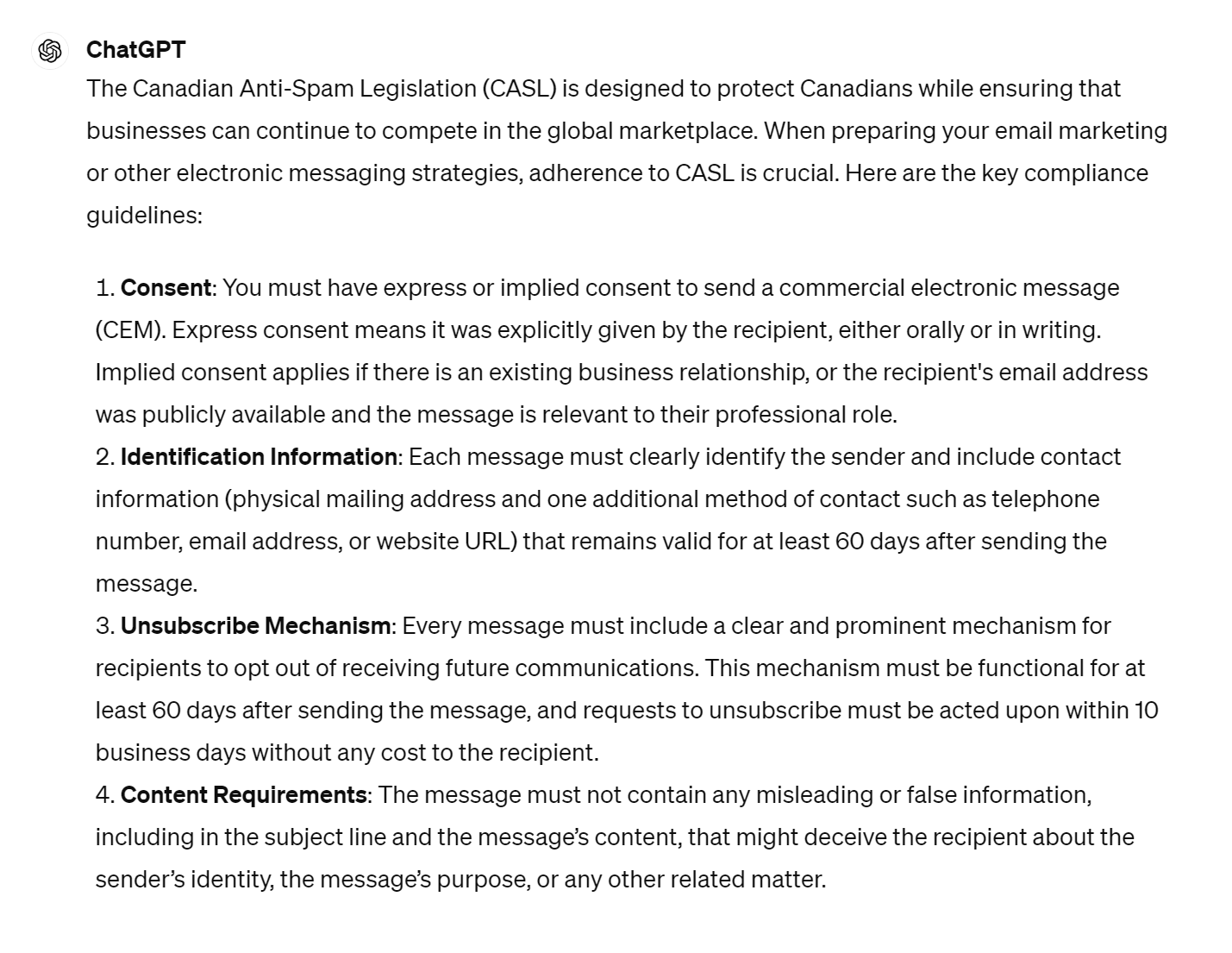
Bonus compliance prompt
Want to make sure your body copy complies with the above regulations? You can check through ChatGPT.
Here, we used the storytelling copy for our hypothetical eCommerce store above to find out.
Prompt: Is this email copy [GDPR/CAN-SPAM/CASL] compliant? [Paste body copy]
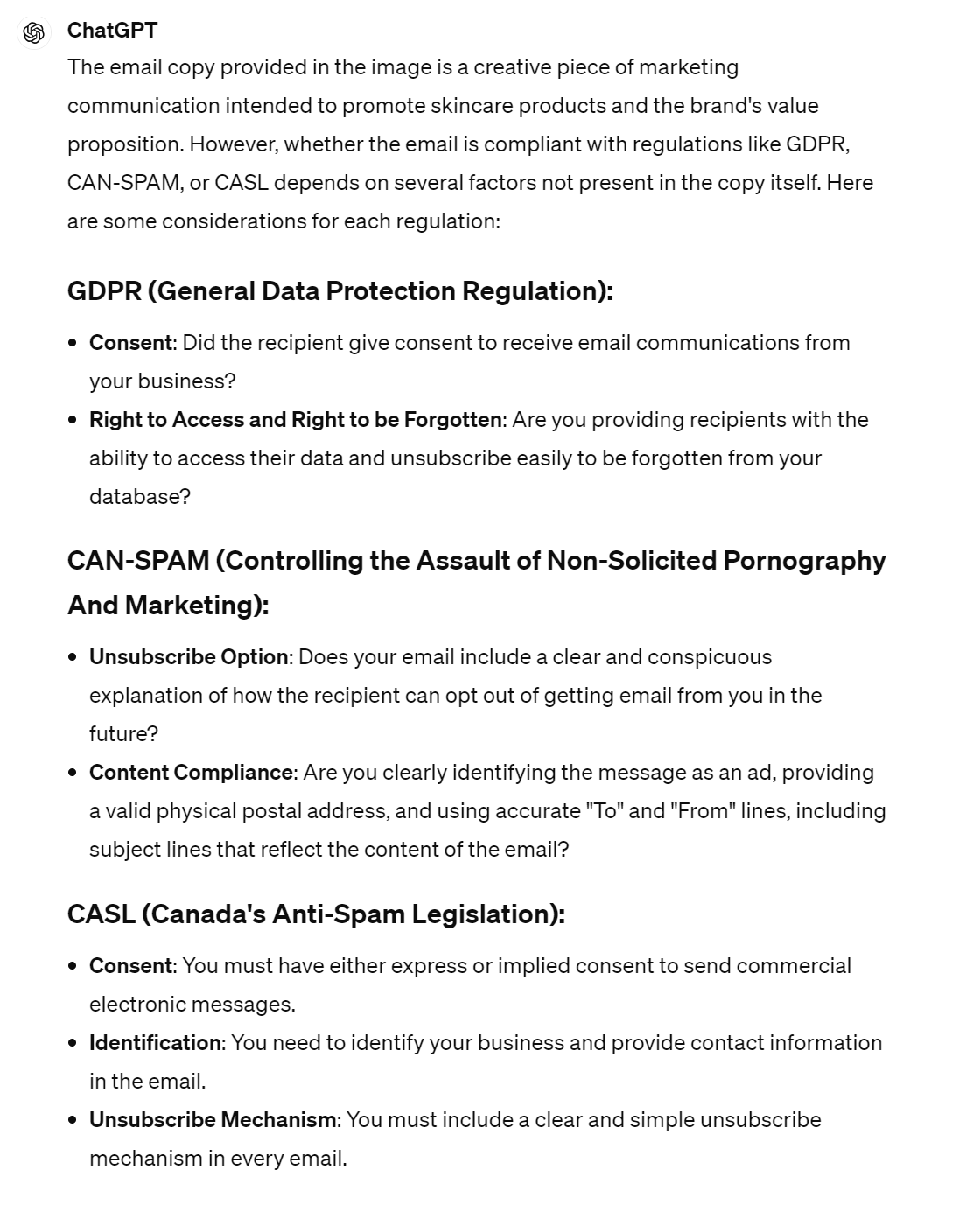
Best Practices When Using ChatGPT for Email Marketing
Before you start generating your next email marketing campaign, there are a few best practices you should keep in mind to ensure you’re producing the kind of campaigns that you’re proud to send to your customers.
Be as precise as possible
Sure, you can get results with vague prompts. But they simply won’t be as good as if you’d taken the time to be specific and carefully laid out the details you wanted to include.
Describe your business in detail, including the name, the products or services you sell, and any other information that will help your results be relevant and accurate to you.
Don’t forget to use the C.R.E.A.T.E framework to get more relevant output.
Keep your information private
ChatGPT is currently in ‘research preview’ mode. That means a member of OpenAI’s staff could review the information you give as they improve their system.
Don’t include personal information; instead, use ChatGPT’s temporary chat feature.
Monitor the results of your AI-generated email campaigns
Monitoring is a crucial part of any marketing campaign, and AI-generated campaigns are no different.
Be sure to run A/B tests to try out different subject lines, body copy, CTAs, and other elements, and monitor which campaigns perform the best. Use the results to inform future campaigns and aim for continuous improvement.
This is where an email marketing platform with advanced tracking and reporting features, such as Moosend, can be particularly beneficial.
A dedicated tracking feature will enable you to monitor key performance metrics, such as open rate, click-through rate (CTR), and conversion rate, providing an in-depth understanding of how your campaigns perform and what resonates with your customers.
The platform will then compile this information into an easily digestible report that can be shared directly with stakeholders, ensuring everyone stays informed about what works and what doesn’t.
Use human expertise along with ChatGPT
While using ChatGPT or any generative AI tool in your email marketing can save you a lot of time, it’s important to remember that the results are only as good as your prompts.
Ensure that you leverage human expertise throughout the process to guarantee that your content is of high quality. The last thing you want is to skip this step and send subpar content to your customers, or out-of-date or incorrect information.
That includes your copywriting team. ChatGPT is a language model, so its generated content isn’t always worded correctly and sometimes includes grammatical errors.
It’s best to get one of your copywriting experts to double-check the content before sending it. They can also help you improve the copy in areas where ChatGPT may be lacking.
Ready to Test Out Your New ChatGPT Email Marketing Prompts?
ChatGPT can be a beneficial tool to have in your digital marketing stack as it has numerous applications, as we’ve seen.
However, it has limitations, particularly if you’re using the free version. For starters, at the time of writing, the latest knowledge update is from 2023. That means some of the information it returns may be outdated, so you’ll still need to research it yourself.
You could upgrade to the premium version, but that means paying for yet another tool in your email marketing stack.
Instead, you could opt for email software with built-in generative AI functionality, like Moosend. With the AI Writer and the AI-powered product recommendation, you can build personalized, engaging emails, segment your audience, and grow your lists, all from one place (and for one price, too).
You can try Moosend for free and see how you can integrate artificial intelligence into your email marketing campaigns.
